Funding disparities lead to PAUSD facility differences
On May 21, 1964, the Palo Alto High School (Paly) Campanile published a story titled, “Henry Gunn nears completion; many unique features included,” which touted facilities such as the “950-seat auditorium, 2,000-seat football bleachers, 1,800-seat gym and a 10-lane, crushedlava track.”

Recently, however, differences between Gunn and Paly’s campuses have grown, with Palo Alto Unified School Dis trict (PAUSD) spending more on improving Paly’s over the past decade than Gunn’s. The history behind the two sites is complex, involving public funding, private donations and relative facility ages.
Construction Funding
In PAUSD, school construction projects undergo a lengthy process for funding and approval, involving vari ous organizations. The Board of Education approves each project and directs the overall plans, the equity committee promotes diversity and equity, and the bond oversight committee ensures projects align with the directives of government bonds.

The three groups come together to decide what facilities problems need to be addressed at each of the 17 schools in the district. According to Director of Facilities Eric Holm, the majority of the sites’ issues are reported by community members, including teachers, principals and parents. From there, the projects are prioritized from most to least important, before the project list and budget plans are approved by the Board of Education and formatted into a grant proposal.
After construction plans and funding methods are finalized, the district sub mits the specifications to the Division of the State Architect for approval. The entire process, from the initial project idea to the start of con struction, can take around two to three years.
Gunn and Paly have similar acreages of developed space—such as athletic fields, classrooms and construc tion spaces—with 39 and 41 acres respectively. However, annual financial reports of the public bond program from 2011–2022 show that PAUSD spent $149.8 million in improving Paly’s campus while only $100 million was allocated to Gunn.
Board of Education Vice President Jennifer DiBrienza attributes the imbalance to the age of Gunn and Paly’s re spective campuses. “[Paly] was the first high school [built in the district] so those buildings hit the end of life before [Gunn’s] buildings,” she said. “At some point, [the board] is going to say, ‘That building has hit the end of its life here
million. PAUSD, however, footed only $18 million, with the majority coming from a donation by the Peery Foundation. Paly’s state of the art complex cost significantly more than Gunn’s Titan Gym, which came in with a price tag of $12.9 million in 2012. While the Peery Center includes partitions to allow multiple teams to play at once, an athletic store and a coaches’ suite, the Titan facility only consists of a main gym, weight room and dance room.

Holm noted that the Peery Family Center was an anomaly, with 99% of PAUSD’s facilities funding coming from bond funds. The bonds that are still available to fund projects are the 2008 Measure A Strong Schools Bond and 2018 Measure Z Strong Schools Bond, providing $378
Funding—p.2

at Gunn, so we’re going to need to replace it.’ That’s why Paly has newer buildings. [The same will] start happening [at Gunn] in the next couple of decades.”
The Peery Family Center—Paly’s new gymnasium com plex—finished construction in May 2017 at a cost of $44
 Michelle Koo and Chinyoung Shao
Michelle Koo and Chinyoung Shao
Palo Alto Unified School District Henry M. Gunn High School 780 Arastradero Rd Palo Alto, CA 94306 NON-PROFIT ORG U.S. Postage P A I D Permit #44 Palo Alto, Calif. PG. 13 Sports Check out senior Allison Lee’s badminton feature! Check out our website! gunnoracle.com
Charlotte Qian and Michael Zhang Online Editor and Lifestyle Editor
Follow us on social media @gunnoracle
“At some point, [the board] is going to say, ‘That building has hit the end of its life here at Gunn, so we’re going to need to replace it.’”
Board of Education Vice President Jennifer DiBrienza
Monthly highlights: Homecoming Week

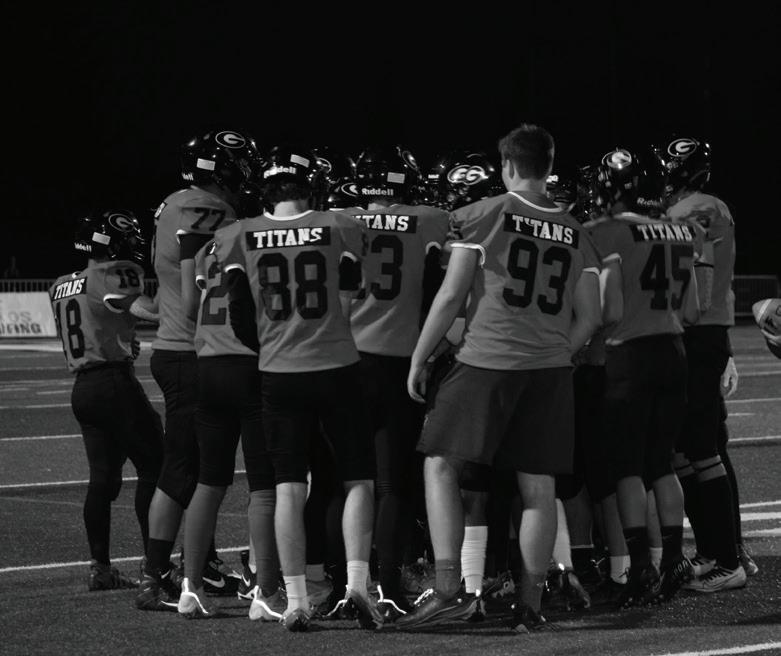
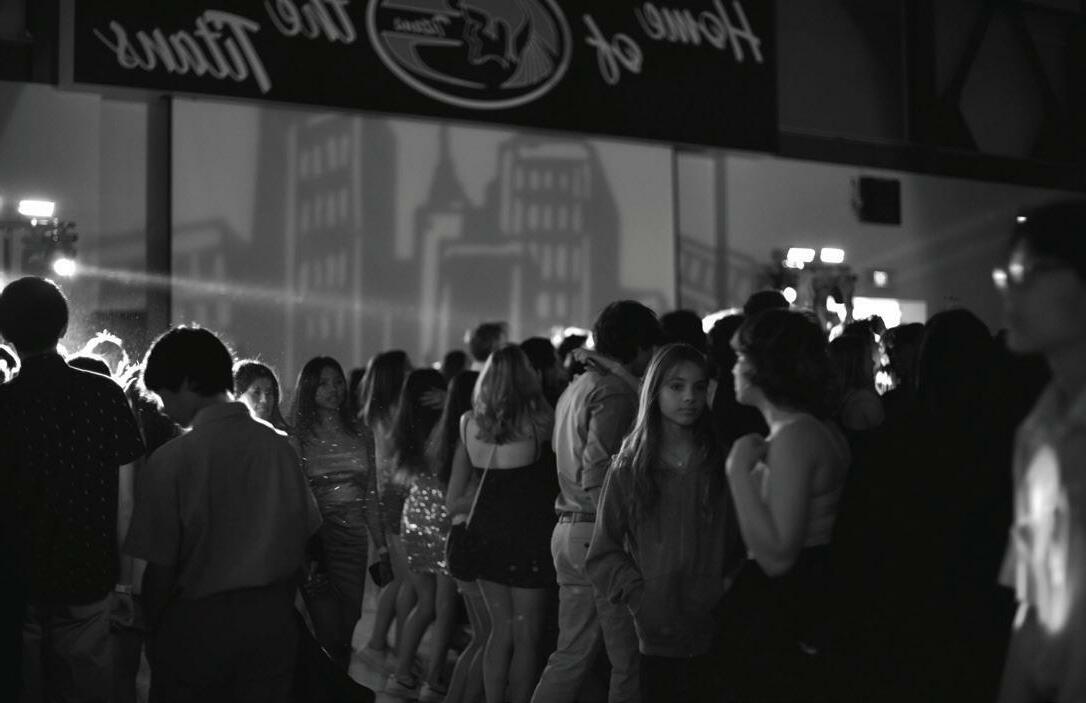



Funding gap leads to facility differences

million and $460 million for expenditures on district facilities. Funds for both construction and maintenance of facilities in PAUSD come almost exclusively from bonds. Since the district’s founding in 1893, only two modern construction projects have been predominantly funded by private donations: the Peery Family Center at Paly and the multi-purpose room at Addison Elementary School. Paly was due for a new gymnasium, and with the Peery family donation, Paly’s new athletic center project was moved to the top of the project list. Paly’s original design would have been simpler, but the donation resulted in a more elaborate design and complex layout.
Recent Projects
The Building A, B and K construction project is part of the 2018 bond funds to renovate Gunn administrative workspaces and move science classes out of the Village portables. The project is currently projected to total $30.8 million, with plans to demolish and rebuild the area. The parallel project at Paly is the renovation of the original, 100-year-old Tower Building. The structure has needed significant repairs during the past decade, including a boiler replacement that cost nearly $1 million in 2012. Currently, the entire renovation and preservation of the Tower Building is estimated to cost $20.1 million.
One difference between the two schools is the technology in their theaters, both of which have undergone recent renovations. The Spangenberg Theater at Gunn includes basic lighting, audio and video services. On the other hand, the Performing Arts Center (PAC) at Paly has a Meyer Constellation sound system with improved acoustics and a two-way radio in addition to the features in Spangenberg.
Furthermore, the Gunn dressing rooms and green room do not directly lead to Spangenberg. Instead, the two areas are shared with the Little Theater; accessing the Spangenberg stage from the green room and dressing rooms entails long walkways and multiple sets of doors. In contrast, the PAC has backstage hallways, green rooms, bathrooms and dressing rooms that are all directly connected to the stage.
According to Holm, the differences can largely be attributed to the two projects’— Gunn’s Central Building and Paly’s PAC— distinct needs. “Because [PAUSD] has older campuses, they are constantly in a state of renewal,” he said. “Paly [had] the PAC built because the Haymarket Theater was too old,” he said. “The addition to Spangenberg was an effort to provide classrooms that were needed for [subjects] that supported [Spangenberg and the arts].”

Although practical reasons may underlie some of the differences in Gunn and Paly’s facilities, many students have noticed the inconsistencies between the two schools. In a poll sent to all Gunn students with 200 respondents, over 90% of students surveyed said that the disparity between facilities was significant, with 36.8% saying that the difference was very significant. Junior basketball player Ethan Fu, who has played in both Gunn and Paly’s respective athletic facilities, commented on the matter. “I don’t think Paly’s better facilities give their team much of an upper hand,” he said. “The Paly facilities are definitely better though.”
Having been on both campuses, former Paly student and now Gunn sophomore Nithila Subramanian has also noticed differences between the two facilities. “I’m on the fence about which school’s [campus] I prefer, but the differences between [Gunn and Paly] are stark,” she said.
Quotes compiled by Sophia Hwangbo
“I enjoyed the increased turnout and how much the underclassmen were participating; it was much louder and [there was] definitely more energy.”
—Vincent Boling, 11
“The atmosphere was insane and really hype. Having everyone together at one place being so spirited is just so special and there’s nothing like it.”
—Melinda Huang, 10
Junior Ethan Kitch gets ready to shoot in the basketball game against the sophomore team during lunch.
Juniors cheer on their fellow classmates during Shooting Stars.
Seniors Nico Ross and Pooja Bucklin host and commentate during Night Rally.
Students enjoy the Homecoming Dance themed “Gone Abroad.”
The seniors on Homecoming Court pose together with their sashes and crowns for a picture on the football field.
The varsity football team strategizes during the Homecoming Game against Cupertino.
Yoochan An
Yoochan An
News
2
Funding—p.1
Yoochan An
Gracie Easton
Gracie Easton
Chinyoung Shao
THEORACLE
780 Arastradero Rd. Palo Alto, CA 94306 (650) 354-8238 www.gunnoracle.com
Editorial Board
Editor-in-Chief
Katie Shih
Managing Editors
Raphael Semeria
Arjun Shah
News
Michelle Koo
Chris Lee
Safina Syed
Forum
Carly Liao Amann Mahajan
Features
Katie LaWer
Irene Tsen
Madison Yue
Centerfold Lise Desveaux Hila Livneh
Sports Kenneth Soh Ellie Yuan
Lifestyle
Vivian Studdert
Becca Wu Michael Zhang
Online
Kaitlyn Chen Charlotte Qian
Photo Editor Chinyoung Shao
Graphics Editor
Irene Hong
Staff Business/Circulation

John Li Kelvin Xu
Oracle/SEC Liaison Safina Syed
Graphics Artists
Elise Hu
Michelle Koo
Aarushi Kumar
Natalie Lam
Jenny Lee Aeron Man Chinyoung Shao
Ruhani Suresh
Photographers
Yoochan An Gracie Easton Grace Gao
Sophia Hwangbo Owen Koehler
Naomi Wang
Reporters
Diya Bose-Malakar
Maddie Cheung
Victor Dang
Paul Garofalo
Dan Honigstein
Sophia Hwangbo
Lita Sone
Bryan Xiao Fiona Xiong
Adviser Kristy Blackburn
Have feedback on this issue? Complete our feed back form at tinyurl.com/ OracleOct2022
Key propositions to keep an eye on this November
Every other November, California citizens participate in direct democracy by not only voting for government officials, but also various ballot propositions: measures that allow voters to decide various laws and constitutional amendments.
Propositions can be placed on the ballot in two ways. First, a twothirds supermajority vote in both the California State Assembly and California State Senate allows legislators to send an issue directly to voters. Second, propositions can also become eligible for the ballot through citizen petitions. Initiative petitions propose the creation of new statutes or amendments to the state constitution. On the other hand, referendum petitions propose a public vote on a law already
Proposition 1: Abortion
Proposition 1 is a constitutional referendum proposed by the California State Legislature following the United States Supreme Court’s 2022 Dobbs v. Jackson Women’s Health Organization decision that grants states the right to decide abortion legality within their borders.
If passed, it would amend the California Constitution to expressly protect abortion legality. Individuals would be able to make reproductive care decisions—like choosing contraceptives or having an abortion—without the threat of state interference.
If Proposition 1 fails to pass, the state constitution would not be amended to specify the protection of reproductive rights. These rights, however, would continue to be protected under California law, which protects legal abortions up to the fetal viability in the uterus, where a fetus is likely to survive outside the uterus, and other reproductive rights. Funds allocated to expanding reproductive healthcare services for the 2022–2023 fiscal year would continue to be distributed.
Proposition 28: Education
Proposition 28 requires the state to establish a fund specifically for music and arts education in public schools. The campaign was launched by former Los Angeles Unified Superintendent Austin Beutner last November, and was placed on the ballot through citizen petitions.
This proposition relates to Proposition 98, which guarantees a minimum annual funding level for public education. Under Proposition 28, schools would receive an amount equivalent to 1% of the funds they received from Proposition 98 the previous fiscal year.
Proposition 28 does not implement a new tax for California citizens, instead relying on California’s recent budget surpluses. The California Legislative Analyst’s Office notes that the ballot initiative would lead to $800 million to $1 billion in additional state spending.
If the proposition fails, schools would continue to receive state funds under Proposition 98, but no fund would be created specifically for public music and arts education.
passed by the state government.
California’s ballot proposition system is one of the few instances where voters are able to directly express their views on issues important to them.
This year, citizens will have the opportunity to vote on seven propositions, the fewest since the 1916 general election. With this in mind, The Oracle has compiled overviews—along with what will happen if a measure does or doesn’t pass—of four propositions that affect students in order to help the Gunn community cast an informed ballot this year.
—Written by Chris Lee
Proposition 27: Gambling
Proposition 27 is a petition about the legalization of online gambling that was placed on the November ballot after it garnered enough signatures.
If passed, the proposition would allow licensed Native American tribes and gambling companies to offer online sports betting to those over 21 years old on non-tribal lands. The proposition would amend the California Constitution and state law to legalize online sports betting by Sept. 2023, allowing bets on professional sports games and some non-athletic events. The state would gain revenue from a share of sports bets made and use the funding to address homelessness and support regulatory costs (including operating a new state unit to regulate online sports betting).
If Proposition 27 is voted down, sports betting would continue to be illegal in California. State gambling and enforcement laws would stay the same. Some forms of gambling are currently allowed under state law, such as tribal gambling, the state lottery, cardroom betting and horse racing betting.
Proposition 31: Tobacco
Proposition 31 is a referendum on California Senate Bill 793 (SB 793), which was passed in Aug. 2020 to ban the sale of flavored tobacco products. The law is yet to go into effect due to this referendum.
If citizens vote “yes,” the contested legislation would be upheld, and the ban on flavored tobacco products would be implemented. The Committee to Protect California Kids is leading the campaign for upholding the legislation, along with the support of Governor Gavin Newsom, the Democratic Party of California and the California Teachers Association. According to the California Legislative Analyst’s Office, California could lose up to $100 million in lost tax revenue due to SB 793.
If voters vote “no,” the law would not go into effect and flavored tobacco products would remain legal in the state. Californians Against Prohibition has led the campaign for voting down the legislation, alongside the Republican Party of California and the National Association of Tobacco Outlets.
—Compiled by Chris Lee and Irene Tsen
INBOX
The Oracle strongly encourages and publishes signed Letters to the Editor and Comments. Comments are generally shorter responses, while Letters are longer pieces of writing.

Please include your name, grade and contact information should you choose to write one.
“I loved seeing the gender neutral locker room story on the front page, since I feel like that’s something super important.”

—Jack Poon, 12
“I didn’t really like the formatting for pages 12 and 13—the advertisements were very distracting.”
—Jerry Wang, 11
“I liked the sections about preps and students’ favorite buildings. I thought that [they were] fun reads.”
—Natalie Chan, 9
Letters and Comments may be edited to meet space requirements, and the writer is solely responsible for the accuracy of the content.




Letters to the Editor, Comments and ideas for coverage may be sent to oraclegunn@gmail.com. These letters do not need to be from current students.


Go to gunnoracle.com to read about the LGBTQ+ community rally and other online exclusives!

News 3Friday, October 28, 2022
—Sept. 23, 2022—
Michelle Koo



4 A dvertisement
should us colleges get rid of holistic admissions?
Paul Garofalo Reporter
The college admissions system is integral to the growth of generations in a country, heavily impacting the labor market and the futures of the applicants. The question of what the best admissions system entails has led to vigorous debates between policymakers, students and parents alike. Two main systems drive the debate: traditional vs. holistic. A traditional system is where applicants are primarily judged based on their performance on an exam, while a holistic system looks at the numerical information, such as a student’s grades, and the nonnumerical information, such as essays and extracurricular activities. The holistic system sounds like the obvious victor; however, this viewpoint is superficial. Probing deeper, such a system is often discriminatory and may not provide each applicant with equitable access and chances to be admitted into college. It is also often based on murky, opinionated information from the college admission officers. Colleges in the United States should consider an alternative to the holistic admissions system to enable a more pragmatic and overall beneficial system.
The implementation of the holistic system varies tremendously from school to school, but the general consensus is that all of them are immensely different from the traditional application system used by almost every other country in the world. That's right—the U.S., aside from some countries such as Denmark and Israel (for certain non-selective schools), is one of the only countries that uses the holistic system. There are many driving factors that led the U.S. to embrace this system, including student creativity, anxiety, stratification and informal private tutoring, also known as shadow education. However, the holistic approach that colleges use to combat these issues is often unclear and nontransparent. This has led to complications such as antisemitism, most notably shown in landmark studies on Ivy League admissions in the 1980s. One such study by Oliver B. Pollack, as part of the Indiana University Press, has shown prejudice against Jewish people in the college admissions process.



Another question comes up when comparing the U.S. to other countries: If the holistic system is good, why hasn’t any other country implemented it? The simple answer is that many countries don’t see the fairness in this ambiguous system. Let’s take a few examples. The most famous counterexample is the system that China and India utilize. Chinese students take a national exam known as the gaokao, are sorted into categories and are ranked every summer. Indian students also take standardized tests such as the IELTS, TOEFL, GRE and JEE, just to name a few. Societal and racial inequities are accounted for by providing extra points for students in less developed areas. South Korea has the same system using the CSAT. Overall, these systems are all quite clear in giving information on what students must prepare for.
A common argument supporting the holistic system is that it judges the student as a whole, rather than as a set of numerical values. However, this just seems like a way for schools to not have to explain the decisions that are made, as a few essays, questions and activities do not begin to display the student “as a whole.” The truth is—even admitted by most admissions facilities—students are going to be judged on the basis of some indefinable quality that transcends the materials provided, with each school weighing distinct aspects differently.
Overall, a more transparent admissions system should be implemented to give applicants a clearer goal to aim toward while eliminating factors such as personal bias. Social and racial equity should also be incorporated into this system, not unlike the structures in many other developed countries. A nonholistic admissions system is the key to making higher education truly more equitable in the United States.
 Kelvin Xu Business Editor
Kelvin Xu Business Editor



Colleges should not get rid of the holistic admissions system. A holistic review is a strategy used by universities and colleges to evaluate whether a prospective student is a good fit by evaluating both their academic prowess and non-academic characteristics. American colleges formerly used non-holistic admissions in the early 20th century, but that was changed to the current holistic system by recommendation from higher education professionals. These professionals found that while test scores and grades might be important, they don’t paint a full or accurate picture of the student. The fault with using a non-holistic admissions system is exactly that: The admissions system doesn’t assess a candidate’s experiences or passions and interests, only their grades and test scores. In exchange for obtaining elite academics-based students, the non-holistic system cripples students whose talents lie elsewhere.
Holistic college admissions utilize a more equitable procedure when evaluating potential students. The holistic approach is popular among American colleges today largely because it allows admissions officers to assemble a more diverse student body. In this context, diversity doesn’t only include race or ethnicity, but also socioeconomic status and life experiences. A common misconception about the holistic process is that colleges use soft factors—extracurricular activities, unique experiences and teacher recommendations—as the deciding factors for potential students. In reality, they are taken account of by the admissions officers, but are not the deciding factors.
In a nutshell, the holistic process was designed so institutions can assess an applicant based on a broad range of elements. The International Graduate Admissions report outlines the holistic system as a way to “look beyond just the objectives like test scores and GPA to really try to get to know the applicant as a student and as a person.” The U.S. Supreme Court describes the review process as a “highly individualized review of each applicant’s file, giving serious consideration to all the ways an applicant might contribute to a diverse educational environment.” All things considered, the holistic approach allows colleges to not only evaluate an applicant as a student but also as a human being.
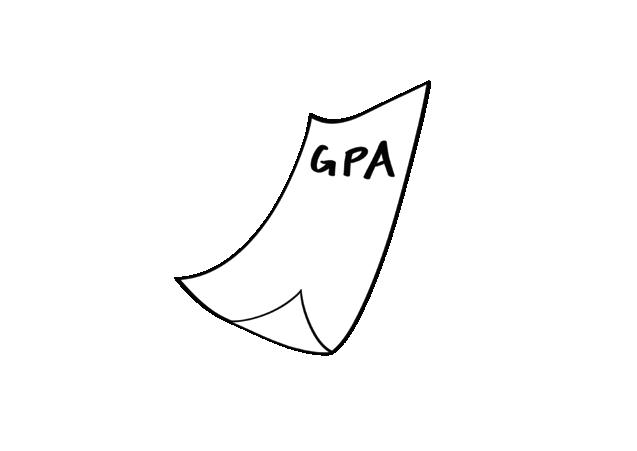


A holistic approach also balances opportunities for students who possess fewer educational privileges and those with learning disabilities. Aside from having to work through more costs and cultural differences than their more privileged peers, many of these students don’t even have the option of considering further education as a viable choice. For many students, a holistic review system is the difference between whether they can even attend college or not. Holistic college admissions are the way to bridge the gap between these students and their more privileged classmates.
A common concern with the holistic system is that the admissions officers may possess biases toward certain applicants based on factors such as ethnicity, age, religious beliefs and more. To combat this, multiple admissions officers are required to go over the same application to make better selections and minimize bias. They are also discouraged from letting personal bias affect their decisions, as severe legal action may be taken against them if biased decisions are discovered.
The holistic system creates a more equal procedure when assessing candidates, judging applicants as both students and human beings. On top of this, it balances opportunities for students that possess few educational privileges. Holistic admissions officers are able to evaluate students by their unique life experiences to see if they’d be a good fit for their school. Although there are drawbacks to this system, the pros far outweigh the cons, and, thus, U.S. colleges should continue using the holistic admissions process.

ADMISSIONS
5Forum Friday, October 28, 2022
YES
NO
Graphics by Elise Hu and Jenny Lee
Classic Halloween movies contain misogynistic portrayals of women, perpetuate stereotypes
Wendy’s stuck in her bathroom. Her husband is approaching quickly, axe in hand. He hammers down the door with the intent to kill. Screaming and pleading, she is rendered helpless in a corner with no option but to await her fate. She ultimately escapes, still hysteric and heavily scarred. This is a scene from “The Shining,” an iconic horror movie which quickly established itself as a classic. Despite critical praise, the film contains blatantly offensive portrayals of women that clearly do not hold up under modern standards. “The Shining” is not alone in its perpetuation of harmful tropes and stereotypes. Indeed, throughout the horror genre, there is a common theme of women being portrayed as helpless and naive. As Halloween approaches, students turn to horror movies as a way to celebrate the holiday. It is important to acknowledge the offensive portrayal of women in many classic horror movies and recognize how Hollywood has made recent strides to remedy this issue.
When teenagers watch these movies, it is important for them to note that this normalization of women as victims is problematic. It paints them as weak, undermining not only the fictional women on the screen but the real women worldwide as well. Even though these movies are not true stories, the misogyny behind them is very real. It is important for teenagers to realize that these Hollywood classics, which have been acclaimed for decades, are deeply rooted in sexism.
“The Shining,” released in 1980—a period far less forward-thinking than ours—is an excellent
taking his word as law. This is both before and after her husband Jack starts to descend into insanity. Stephen King himself, the author of the novel the movie is based on, stated during press interviews that “The Shining’s” version of Wendy was in no way accurate to the written description. King’s version paints Wendy as a woman with some level of independence and confidence. By portraying Wendy as weak and timid, the film not only fails to abide by the source material, but also shows how Hollywood tailors its movies to fit the standards of a typical horror film.
“The Shining” is the epitome of a classic Hollywood horror film with derogatory implications for women, as it features a submissive and weak female character left helpless at the hands of an overly dominating male figure. As people view “The Shining” in all its glory, what they are really getting is the portrayal of an abusive relationship with a helpless and uninteresting female protagonist.
The typical girl in distress trope that “The Shining” embodies is in no way the only way misogyny is portrayed in horror films. Another classic, the “Texas Chainsaw Massacre” film series, has its fair share of blatant misogyny. This series of films portrays oversexualized women submitting to the will of ferocious men. In particular, the second movie of the series is entirely based on the capture and assault of a woman named Stretch. During her abduction, Stretch is threatened and abused, not only by her two abductors, Leatherface and Chop-Top, but by other male characters. She suffers blows to the head with a sledgehammer and is treated as Leatherface’s possession—as if she has no mind of her own.
In movies where men or younger males get kidnapped, such as “The Black Phone,” the boy gets out due to his own free will and physical prowess. The incapability of women to defend themselves in horror movies serves as a window into how greater, male-dominated Hollywood sees them.


Yes, at the end of the movie, Stretch does change the narrative by becoming the one wielding the chainsaw, giving her some power, but the scene in no way redeems the entirety of the film. In fact, the scene looks even more out of place, created as if to fulfill some kind of requirement to check off the feminist box.
Many say that the misogyny in earlier movies led to Hollywood’s shift to more feminist horror. Even the greatest horror movies have flaws, and countless articles have been written about the hidden and not-so-hidden sexism within them. This led to a global conversation about female representation in horror as people began to understand the harm of depicting women this way. Because of these movies and discussions, people are able to recognize that the film industry has not always been a kind place for women. They also argue that these slasher films were able to show a glimpse of what it means to be a woman. A survey by nonprofit Stop Street Harassment found that 81% of women experienced sexual harassment in their lifetimes. Recently, however, as Hollywood has become more inclusive and begun to portray women as strong, the tide has changed. Now, women are becoming the heroes of their own stories, such as in “Ready or Not,” a 2021 film that follows the story of a woman and her experiences playing a deadly game of hide and seek with her familyin-law. If any member of the family finds her, she will be killed. She takes it upon herself to find a way out of the game without anyone’s help. She demonstrates intelligence and skill, physically as well as mentally, which had not been major strong points of earlier female characters. Another movie, “Jennifer’s Body,” shows a woman who takes control of her life again after going through the traumatic experience of rape. These are only some of the


6 Forum
52.9% of students surveyed felt women in classic horror films have little to no agency.
Irene Hong
Lise Desveaux Centerfold Editor
Then Source: Survey sent out to Gunn students, with 200 responses. [Classic Halloween movies paint] them as weak, undermining not only the fictional women on the screen but the real women worldwide, as well. The
incapability of women to defend themselves in horror movies serves as a window into how greater, male-dominated Hollywood sees them.
Now
Students should show respect, sensitivity for others’ enjoyment of ‘basic’ items


 Carly Liao Forum Editor
Carly Liao Forum Editor



It’s that time of year again: the autumnal chill sets in, Halloween decorations adorn the front of every house and of course, the sweet smell of pumpkin spice lattes wafts through the air. The latter item, a simple coffee order though it may be, has sparked numerous debates in popular culture about whether it is truly deserving of its reputation as the quintessential fall drink. Many provocative food bloggers have unabashedly deemed the pumpkin spice latte overrated and “basic,” stating boldly that it doesn’t live up to the hype. Yet disdain for the pumpkin spice latte seems to stem from a deeper source than simply a dislike for the flavor. The hate is not solely due to the perception that pumpkin spice lattes taste bad, although everyone is certainly entitled to their own opinion on that matter; it is because of the fact that everyone, or at least everyone from a predominantly young, female population, seems to like them. Indeed, many socalled “basic” items are categorized as those products and trends often thought of as unoriginal, unexceptional and mainstream. Rather than frowning upon those who enjoy pumpkin spice lattes and other “basic” items, people should respect others’ tastes and preferences without ridicule and open themselves up to perhaps enjoying those experiences as well.
The issue of casual misogyny is not exclusive to pumpkin spice lattes. When young women make up the majority of a fanbase for anything, be it UGG boots, romantic comedies or Taylor Swift’s music, that item tends to be looked down upon with derision and written off as “low culture.” The very phrase “teenage girl” is often used derogatorily, as if to be a girl in her adolescence is to be, by definition, empty-headed and shallow. It could be argued that the “Fast & Furious” and “Twilight” franchises contain equal levels of superficial entertainment value, yet one undoubtedly carries more respect in popular culture than the other solely by virtue of its target audience. “Still a better love story than ‘Twilight’” is a common ironic comment on social media, though it is unlikely that “still a more sensible plot than ‘Fast & Furious’” has ever crossed someone’s feed. While it is within human nature to push back whenever the majority of the population tends to lean one way, this phenomenon seems to affect items beloved by teenage girls more than those enjoyed by any other demographic.



The knee-jerk reaction of many to look down on so-
called “basic” items is not just reflective of wider cultural misogyny. It is a shame for those who deny themselves the opportunity to enjoy something just because the majority of other people do. Pumpkin spice lattes, while admittedly not the best Starbucks has to offer, bring a sense of warmth and nostalgia to their enthusiasts with every sip. Fairy lights and scented candles make every room feel cozier, while UGG boots are optimized for comfortable wintertime wear when the temperatures get low. One will be hard-pressed to find a greater joy in life than blasting the occasional Taylor Swift song at top volume just for the fun of it.
In short, though they may not appeal to everyone, these “basic” items are meant to spark joy and comfort. No one deserves to be mocked for taking pleasure in something deemed “basic” just because many other people enjoy the same thing.
Of course, not everyone is required to like “basic” things. While widespread hatred of “basic” items in popular culture often contains disrespectful and even misogynistic undertones, some people simply don’t enjoy the admittedly sugary taste of pumpkin spice lattes or the cloying, manufactured aroma of scented candles. There are even valid criticisms of “basic” items that go beyond labeling them as “overrated” or “shallow:” for example, according to “Rolling Stone,” Taylor Swift has been reported to fly her private jet more than any other celebrity this year, emitting an estimated total of over 7,000 tons of carbon dioxide so far. Such concerns are rational, even necessary, in holding those individuals and corporations with money and privilege accountable. Still, just as someone can choose to dislike Taylor Swift because of her excessive contributions
to the climate crisis or simply because they don’t enjoy her pop ballad appeal, another person can be just as sensible in appreciating her music for her lyrical prowess and catchy tunes. As long as they are not actively harming or disrespecting others, people deserve to have their tastes and preferences—whatever they may be—respected, regardless of someone else’s personal opinion. This time of year especially will have students flocking to their comfort items, which often include UGG boots, fairy lights and, yes, pumpkin spice lattes. As a result, many may feel the need to hide their affinity toward such items. The next time a student walks into their local Starbucks and feels ashamed about purchasing a pumpkin spice latte, they should remember that their order is just that: a coffee order. Drinking a pumpkin spice latte does not signify shallowness or conformity; it only represents an innocuous preference that should be respected by everyone. If something sparks happiness, enjoy it without reservation: People should never feel ashamed of what they find joy in—that’s a doctrine to follow year-round.
7Forum Friday, October 28, 2022
FACES IN THE CROWD: what is a “Basic” Thing that you enjoy?
—Pranav Pabba (11)—Jessie Han (10) —Aaron Novick (12) “I like going to Target and shopping for room decor. I also really like Starbucks drinks.” “I love Olivia Rodrigo; her songs are so good. I also like Starbucks [coffee].” “I love to drink hot cocoa [because] it’s relaxing. “My favorite basic thing is Hydro Flask water bottles. I always like my water cold and Hydro Flasks get the job done.” —Compiled by
Sophia
Hwangbo When young women make up the majority of a fanbase for anything, [...] that item tends to be looked down upon with derision and written off as “low culture.” As long as they are not actively harming or disrespecting others, people deserve to have their tastes and preferences— whatever they may be— respected, regardless of someone else’s personal opinion. —Lauren Murakami (9) EliseHuandIreneHong
Features

A tale of two schools: Couples navigate joys, challenges of attending different high schools
Seniors Cadence Ghilarducci and Wyatt Underwood
Senior Cadence Ghilarducci and Palo Alto High School (Paly) senior Wyatt Underwood met a little over a year ago at a Civil Air Patrol meeting, and the sparks flew from there. Last year, Underwood took the opportunity to ask Ghilarducci to the 2021 Paly Homecoming Dance.


“At the end of the meeting, she made me sit down on the bench and ask her properly,” Underwood said. They might have spoken too soon, though—unfortunately, Paly didn’t allow visitors that year, so they didn’t actually get to go as a couple. The silver lining, however, is that Ghilarducci and Underwood began dating regardless.
Not being able to go to the Paly Homecoming Dance isn’t the only result of being in a relationship while going to different schools. “If you’re [in] a Paly–Paly relationship or a Gunn–Gunn relationship, you’re going to see that person every day, talk to them every day,” Underwood said. “I do get kind of sad sometimes because I’ll go to school and be like, ‘Oh, [Cadence] doesn’t go to this school.’”
Underwood believes that there are many aspects of relationships that couples who go to the same school may take for granted. “So many things would be so much more convenient [if we went to the same school],” Underwood said. “Going on dates would be so much easier. It’s kind of a
hassle sometimes to plan things and go out.”
However, there are benefits that come from being apart. Ghilarducci enjoys the independence that dating someone from a different school brings. “It’s a good balance,” she said. “You get to see your friends, go to clubs and do your sports without feeling obligated to always be with them every second, but you still get enough time to spend with each other.” Underwood noted that taking the time to plan outings with Ghilarducci makes them closer. “We get to learn from each other better, we get to know what our schedules are like and we get to know what the other person wants to go out and do,” he said. “Planning things with the other person makes it easier to cooperate with that person for more difficult things.”
They also have a system of alternating which school events they go to. “I went to his prom last year,” Ghilarducci said. “He’s going to come to [Gunn] prom this year.”
In terms of the Gunn-Paly rivalry, the couple says it’s all in good fun and they regularly engage in playful banter over it. “I love making fun of her for going to Gunn, and she loves making fun of me for going to Paly,” Underwood said.
—Written by Becca Wu
Senior Ashley Medina and her boyfriend Sebastian Herger have been dating since Dec. 2021. Herger, who attends Mountain View High School, recounted their first interaction.
“The first time we met was on the Fourth of July,” Herger said.

“We coincidentally met on a roof watching the fireworks.”
Since their first meeting (which prompts lots of fireworkrelated puns), Medina and Herger have put significant amounts of effort into making time for one another around both of their busy schedules. “I usually have football practices during the week and [Ashley] usually has work,” Herger said. “[But] we still get to hang out a lot, even though our schedules are pretty tight.”
While the scheduling isn’t so much of an issue, the distance can be. Medina explained that living far from one another can be difficult at times. “Since he doesn’t drive, it’s not optimal that I’m usually the one driving to his school or his house because it’s just too far for him to bike,” Medina said. Herger agreed that the distance between them made meeting difficult. “Usually, if I have to bike to her house, it would take 15 [to] 20 minutes,” he said. “We can’t just walk to each other’s houses.” Furthermore, since their schools are in different districts, many school breaks don’t coincide with one another. “Our breaks not lining up is also [one of the downsides],” Herger said.
However, the couple also noted that going to different

schools does have its benefits. “We talk a lot about how we’re kind of glad we go to different schools because [I] don’t really have to split [my] time between him and my friends, or him between me and his friends,” Medina said.
The added inconvenience of a district-barrier also provides an opportunity for the couple to show their commitment. “It does mean that we go out of our ways to arrange seeing each other,” Medina said. Herger believes that the lengths they go to spend time together is a testament to their devotion.
“It’s a way of showing each other that we care,” he said.





Similarly, the compromises that they make in order to attend each other’s events also strengthen their relationship.
“We didn’t start dating [by] last year’s [Gunn] Homecoming [Dance],” she said. “But we were dating by my school’s Winter Dance,” Herger said. “So she went to my Winter Dance. Usually, the dances don’t line up on the same day, so we can go to both. However, this year, both our Homecoming Dances were on the same day, [so we] decided to go to the Gunn dance because it’s her senior homecoming.”
Overall, Medina and Herger say that their relationship works well—maybe even better than if they went to the same school. “I’m not mad that I’m dating him and that he goes to a different school,” Medina said. “I wouldn’t prefer to date someone at Gunn.”
 —Written by Becca Wu
Graphics by Irene Hong and Chinyoung Shao
—Written by Becca Wu
Graphics by Irene Hong and Chinyoung Shao
8
Photos courtesy of Cadence Ghilarducci
The Oracle’s Favorite Date Ideas 42.8%
Senior Ashley Medina and Sebastian Herger
Photos courtesy of Ashley Medina
Top: Seniors Cadence Ghilarducci and Wyatt Underwood pose for a picture before prom.
Bottom: Ghilarducci and Underwood ride in the bus on route to prom.
Top: Senior Ashley Medina and Sebastian Herger pose for a picture before prom.
Bottom: Medina and Herger ride in the bus in San Francisco on a date.
“You still get to see your friends, go to clubs and do your sports without feeling obligated to always be with them every second, but you still get enough time to spend with each other.”
—Senior Cadence Ghilarducci
“We still get to hang out a lot, even though our schedules are pretty tight.”
—Senior Ashley Medina
of students surveyed are open to dating someone from another school
Source: Survey sent out to Gunn students with 200 responses • Stargazing • Going on picnics • Baking • Eating at local restaurants • Ice skating • Hiking • Playing arcade games • Going to escape rooms • Browsing bookstores
Cultural holiday celebrations integrate established traditions, modern practices

Junior Vandana Ravi: Diwali

Over 2,500 years old, Diwali is a national holiday celebrated by multiple religions. The story of Diwali has various adaptations across the South Asian diaspora, but the festival has a central theme of the triumph of good over evil. While most American holidays follow the Gregorian calendar, Diwali follows the lunar calendar, and as a result, may fall on a different day each year. This year, the festival was held on Monday, Oct. 24.
An important Diwali tradition is to light clay lamps called diyas and place them around the home. The emitted glow is considered to be auspicious. Junior Vandana Ravi shed light on her experiences celebrating the holiday, including traditions that are customary to Diwali. “If you’re in India and you walk down the street, people will usually have them in their windows,” Ravi said. “You light them as a way to represent victory of light over darkness.”
Diwali brings people of Indian heritage together, both in America and abroad. Ravi explained that people celebrate Diwali differently depending on where they’re from. “Amongst
the diaspora in America, every single family has their own tradition,” Ravi said. “Just like with Thanksgiving or Christmas, everyone has their own spin on it. But generally, in similar regions of India, the traditions are pretty similar. There are some things that are universally agreed on, like [the use of] light or color. It’s a joyful holiday.”
Given regional differences, specific deities associated with the holiday tend to vary. Most people, however, typically worship the deity that is associated with prosperity and wealth during Diwali. “From where I come from, that would be Lakshmi,” Ravi said.



To Ravi, Diwali is an opportunity to not only connect to her heritage and culture, but also a time to bond with family. “I was born here, but as an Indian it’s really cool to have a moment to talk to my family about the history and what this ritual meant to them when they were growing up,” she said. “[It’s also nice] to have something in common with my grandparents.”
—Written by Maddie Cheung
Sophomore Ben Levy: Yom Kippur

Yom Kippur, which ended on the evening of Oct. 5 this year, is the most important day of the religious year for Jewish people such as sophomore Ben Levy. Yom Kippur’s significance can be best understood through its direct Hebrew translation: “Day of Atonement.” Ten days prior to and culminating in Yom Kippur, Jews repent for the sins they have committed in the past year and ask for forgiveness. “It’s like a refresher before every new year to wash away your sins,” Levy said.

“You feel great after.”
Perhaps the most well-known element of Yom Kippur is fasting. A common misconception is that the twenty-five hours of fasting on Yom Kippur are meant to simulate suffering. In reality, the purpose behind fasting is to help Jews focus on their praying by eliminating physical distractions.


“When you are in a synagogue all day with no food in you, it makes it feel like a more holy place,” Levy said.

Many Jewish households will prepare elaborate meals to break their fasts, including cuisine from their various Jewish backgrounds. “In my house, it’s a tradition that my dad makes a big meal to
Junior Andre Young: Halloween
On Halloween, which is celebrated on Oct. 31, many people dress up as monsters, ghosts or other characters as part of the holiday. Originally a religious holiday established to ward off dead souls and apparitions returning to the homes of the living, Halloween was popularized in the U.S. in the late 1850s by a new influx of immigrants, particularly from Ireland.
Fast forward to the modern day, Halloween has evolved into a night of trick-or-treating, wearing costumes, eating candy and socializing among the younger generations. Junior Andre Young has participated in Halloween activities since he was a child. “I have celebrated Halloween for basically my whole life, ever since elementary school,” he said.
Today’s Halloween has branched out from its religious origins. “I don’t consider myself as a religious person, and I don’t think that Halloween has the same religious ties as it did centuries ago,” Young said.



















In line with its roots, Halloween continues to be a time for meeting with old friends, as well as making new ones. “I have made dozens of friends of all ages just walking around the neighborhood trick-or-treating,” Young said. “As I grew up, the focus shifted from the candy and the costumes to spending valuable time with friends and family.”
Halloween is also a chance for families to spend time together decorating their houses and preparing candy to distribute. “We haven’t really decorated our house for a while, but we will this year, since we will be moving into a new house,” Young said. “My sister is also returning home from college for the first time in four years, so decorating will be a fun family activity.”
Young has already made plans for Halloween this year. “I’m excited for this Halloween [because] it’ll be the first one post-COVID,” Young said. “I’ll probably dress up as a Hawaiian tourist this time.”
—Written by Paul Garofalo
break the fast,” Levy said. “He’s Moroccan, so he’ll prepare all these traditional foods.”
For Levy, Yom Kippur is significant because of its almost-sacred atmosphere. Perhaps most special is the primordial sound of the shofar, a traditional ram’s horn that is blown at the beginning and end of Yom Kippur to mark the special occasion. “I love going to synagogue,” Levy said. “You get to hear the shofar blow, which is always special for me.”



Finally eating and drinking after a long fast is a comforting moment. Many Jews still look upon fasting with appreciation, perceiving that the practice improves their own physical awareness, cleansing them both physically and spiritually. Levy, too, takes value from this difficult experience. For him, that is where the true beauty of Yom Kippur lies—in the ability to start anew and to see things from a slightly grander perspective.
“Of course, [fasting] is a big struggle, but in some ways, it’s really worth it,” he said.
 —Written by Dan Honigstein
—Written by Dan Honigstein
9Friday, October 28, 2022Features
Photo illustration by Victor Dang and Chinyoung Shao
Photo illustration by Victor Dang and Chinyoung Shao
Photo illustration by Maddie Cheung, Irene Hong and Michelle Koo
Board

education
education
election Election
board of education SHAPES


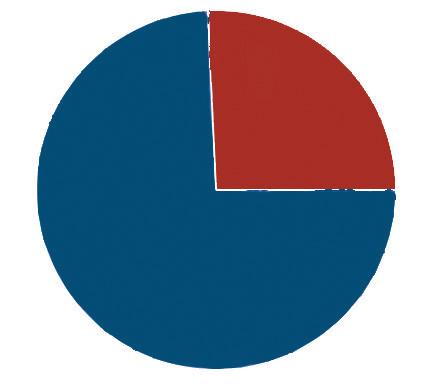

With the duty of oversight and governance, the Palo Alto Board of Education deals with affairs regarding the school community, including: budgets, new curricular adoptions and superintendent supervision. The board is a group of five elected individuals who meet every second and fourth Tuesday of the month to publicly discuss the decided agenda. Of the five, Board of Education President Ken Dauber is the spokesperson, and presides over the regular meetings. Board of Education Vice President Jennifer DiBrienza acts as a stand-in president when Dauber is absent. The two work with Superintendent Don Austin to set meeting agendas.
Decisions taken directly affect the school environments—for example, construction on campus. “We approve construction projects [in the district] to update buildings and [provide] a facility that is conducive to student learning,” DiBrienza said. Board member Jesse Ladomirak explained more about the board’s role in overseeing construction projects. “We approve [the district office staff] going out for bids for construction projects,” she said. ‘Then, we approve the award of contract for projects, so we review the design agreement with architects and authorize staff to proceed with soliciting bids for remodeling. Months later, it’ll come back to us, and [the district staff] will recommend awarding a contract to a firm.” Currently, the board is working on the renovation of A, B and K buildings at Gunn.

Besides construction, the board also shapes the curriculum taught in PAUSD schools, like that of the Social, Emotional, Learning, Functionality (SELF) courses taught in secondary schools. “SELF was something that we approved to happen again this year,” DiBrienza said. “We also formed an ad hoc committee, which means it’s a temporary committee this year, on SELF.” Students, teachers and administrators meet once a month to discuss improvements to the SELF curriculum and recommend changes to the Board of Education. Additionally, according to Ladomirak, the board has taken actions to improve mental health on the campus by hiring therapists and counselors. “In the way mental health is provided, we may be the first in the nation to do it this way in terms of having licensed therapists on staff as opposed to contracted,” she said.
Board of Education decisions play an important role in the Palo Alto community and those eligible are encouraged to vote. Board of Education candidates have different issue priorities, so it is important for voters to vote for individuals who they believe will improve the PAUSD school system. “Make sure you’re electing somebody whose values have the same vision of what school should be and what should matter,” Ladomirak said. “There are a lot of ways a board member can impact the vision, direction and strategy of the district…[so voters should direct] that focus in ways that [they] think are most beneficial.”
—Written By Michelle Koo
Centerfold10
POLICY
UPCOMING UPCOMING BOARD
Are you eligible to vote? DO YOU KNOW WHEN AND HOW TO VOTE FOR THE BOARD of education? Are you REGISTERED to vote? Yes, 74.3% Yes, 60% Yes, 40% No, 25.7% No, 40% No, 60% Source: Survey sent out to Gunn students with 200 responses.
of
of
MEET THE BOARD of education CANDIDATES
shounak dharap
Since graduating from Gunn in 2008, Board of Education Candidate Shounak Dharap has always been a mediator in the community: both as a lawyer and a former board of education member. Now, he is running for a second term on the board of education.

According to Dharap, Palo Alto United School District’s (PAUSD) reputation is being a collegeprep district. Having first-handedly experienced mental pressures, Dharap’s solution is to advocate for universal screening and encourage discussions, shifting the culture of a rigorous district. “[As] our community changes, that institutional knowledge [won’t affect] our community as it had in the past,” he said. “I ran to be part of those conversations [and] push forward on changing how we address mental health.”
Dharap aims to ensure equity in students’ achievement. As chair of the Equity Oversight Committee, he laid out the System-Wide Integrated Framework for Transformation (SWIFT), one of
Ingrid Campos is a Palo Alto parent running for school board on the basis of “traditional family values.”



Although Campos acknowledges that family values can look different to everyone, she values advocating for her own kids within Palo Alto Unified School District (PAUSD). “I want my children to succeed,’’ she said. “I want to be there and advocate for my children in school before any administrator or teacher. I don’t think anyone should think that they have a better understanding of my child than me.”
Campos strongly believes in parental rights. For Campos, that means changing some of the district policies currently implemented. “I believe that sex and politics should stay out of schools,” she said. “School is for education, not for indoctrination and not for social services.”
Trying to advocate for children and parents is one of Campos’s main goals. Her aim is to make sure parents are aware and comfortable with what their children
Dharap’s programs that implemented measures to promote and evaluate equitable experiences. “You hold the district accountable for all the granular additions,” he said. “The step for the next four years is to make sure that all those things are being implemented, that we continue to access oversight and follow through with what we set forth.”
Good governance via increasing school boardcommunity connection is another one of his targets. During Dharap’s last term, he motioned for resuming public virtual participation in board meetings. Dharap also anticipates active involvement with liaisons, listening to rising concerns. “This [is a] very feasible way to get input,” he said. “Board members can report those conversations [as] inputs the district uses to decide what goes on the agenda and what changes get made.”
—Written by Fiona Xiong
incumbment
are learning. Campos cites an experience of having issues with her child’s middle school curriculum. “My middle schooler two years ago was assigned a book that was critical race theory based,” she said. “It was a Marxist-based book, and I was against it. I didn’t want my child reading it.”
Although Campos has created a platform on the basis of having a choice within school curriculum, she has vigorously condemned Scholastic Books for having books containing LGBTQ+ themes and characters.
In her words, Scholastic Books have become “deviant publishers.” Unlike her stances on previous issues, Campos believes that there needs to be a district-wide ban of certain books. “I don’t believe that they should be brought into the school under the guise of Scholastic Books,” she said. “There are other book companies that the school district can bring in for book fairs.”
—Written by Katie LaWer
Nicole Chiu-Wang has experience as an attorney, is co-founder of a clothing brand and is currently a Product and Business Strategy Lead at Google. This year, Chiu-Wang is hoping to add one more item to this diverse list: Palo Alto Unified School District (PAUSD) Board of Education Member.
Chiu-Wang’s experience in education began during her undergraduate studies at the University of California, Irvine. “[While attending Irvine] I was working with 10th graders [at Santa Ana High School] and saw that they weren’t reading at grade level,” she said. “We had gone into the high school to work on world history, but it culminated in working with the other students. Teacher’s assistants and graduate students created supplemental learning materials that were distributed to [more than] 3,500 teachers and students in Santa Ana.”
Through this and similar experiences, Chiu-Wang formed some of the foundational beliefs that guide her campaign today. “If we ever want to have equity,
As a Palo Alto Unified School District (PAUSD) alumni, PAUSD parent, former English teacher at Lynbrook High School and, most recently, a PAUSD substitute teacher, Board of Education candidate Shana Segal has been immersed in public school education her entire life: a quality she believes separates her the most from other candidates. “We need someone on the board with recent in-class experience, PAUSD experience and a background in education,” she said. “As a parent, educator and alum, I can make decisions with different lenses.”
If elected, Segal plans to prioritize community collaboration. “PAUSD has great students, great parents, great teachers and a great community,” Segal said. “We need to make sure we can retain them and raise morale. I am confident I can build back the collaborative community that seems a little bit fractured.” Segal also plans to value community feedback—especially student voice—through being
ingrid campos
NicoleChiu-WangShana Segal
Ingrid campos
if we want to end systemic racism, it starts in school,” she said. According to her campaign website, ChiuWang believes that addressing problems such as socioeconomic and racial achievement gaps should start at early childhood education.
Unlike the other candidates, Chiu-Wang only moved here recently. However, she does not view this as a negative factor for her campaign. “The more people I’ve talked to in the community, the more I hear stories like mine, where they moved here for the schools,” she said. “And that’s an important perspective.”
Furthermore, Chiu-Wang is resisting being labeled and associated with established factions. “I don’t think you have to be either for closing the opportunity gap and serving the historically underserved or for supporting those students that are really already thriving and wanting to accelerate even more,” she said. “Those two things aren’t completely opposed and I don’t think we should think that way as a district.”
—Written by Chris Lee
visible on campus, being easily accessible online and encouraging student representation. “Student voice is very important,” Segal said. “I want students to not only feel heard, seen and respected, but also that there will be follow through.”
Another key priority of Segal’s campaign is to close the achievement gap through a process known as early intervention, which identifies students struggling early on in their academic careers and provides support for them. “Every child, every student only gets one chance in each grade—I understood that as a teacher, but now as a parent, I feel that even more,” Segal said.
Ultimately, Segal’s vision for the future of PAUSD is improved mental health and equity programs, as well as increased school enrollment. “I would like for students to have a variety of definitions of success and for us as a community to really demonstrate that as well,” Segal said.
–Written by Kaitlyn Chen
shana segal
enterfold 11Friday, October 28 2022
Graphics by Aarushi Kumar
Photo courtesy of Nicole Chiu-Wang
Photo courtesy of Ingrid Campos
Photo courtesy of Shana Segal
Photo courtesy of Shounak Dharap
NICOLE CHIU-WANG
NEWCOMER
NEWCOMER
NEWCOMER
Senior ALlison Lee trains for olympics
Thousands of athletes from different countries congregate in the Summer Olympics, an event that occurs every four years. The Olympic Games are the fabled pinnacle of athletics that most cannot even dream of reaching. However, for badminton player senior Allison Lee, competing in the Olympics could very well become a reality. As the date inches closer and closer to the 2024 Summer Olympics in Paris, Lee continues to participate in tournament after tournament in hopes of being a part of one of the eight women’s doubles teams selected.

Like many athletes, Lee’s love for the sport came from her badminton-involved upbringing. Ben Lee, Lee’s father, played men’s doubles in the 1992 Summer Olympics in Barcelona. “Even though I started training competitively at the age of eight, badminton has been a part of my whole life because my parents met through the sport and my dad is a former Olympian,” she said. Badminton has always played a big role in Lee’s life, but competing in the Olympics was not a main goal of hers until recently. “I’ve always had the Olympics in mind, but it wasn’t until the beginning of high school when I started to take it very seriously,” Lee said. “I had to change my mindset to become more committed and think more globally from a tournament perspective.”
To help her develop into an Olympic-caliber player, Lee plays for the Synergy Badminton Academy, a club founded by her parents. She puts in extensive hours of training while trying to balance high school life with her commitment to the sport. Lee plays both women’s doubles and mixed doubles; however, she is currently more focused on women’s doubles as that is the event she hopes to compete in for the Olympics. During her practices, Lee focuses on skills that will help her become a better doubles player. “As a doubles player, you work on quick movements and specific doubles style shots to gain the offensive advantage in each rally,” she said. “We do at least 30 minutes to an hour of physical training, and when we do physical conditioning we focus on full body workouts because badminton is a sport that requires a bunch of different physical demands.”

time every week, Lee noted that she still does not practice as much as other players around the world who are also hoping to make the Olympics. “A lot other countries compete on a
professional level,” she said. “They dedicate themselves to badminton full-time with training and competing. These players focus solely on badminton without having to worry about pursuing an education at the same time.”
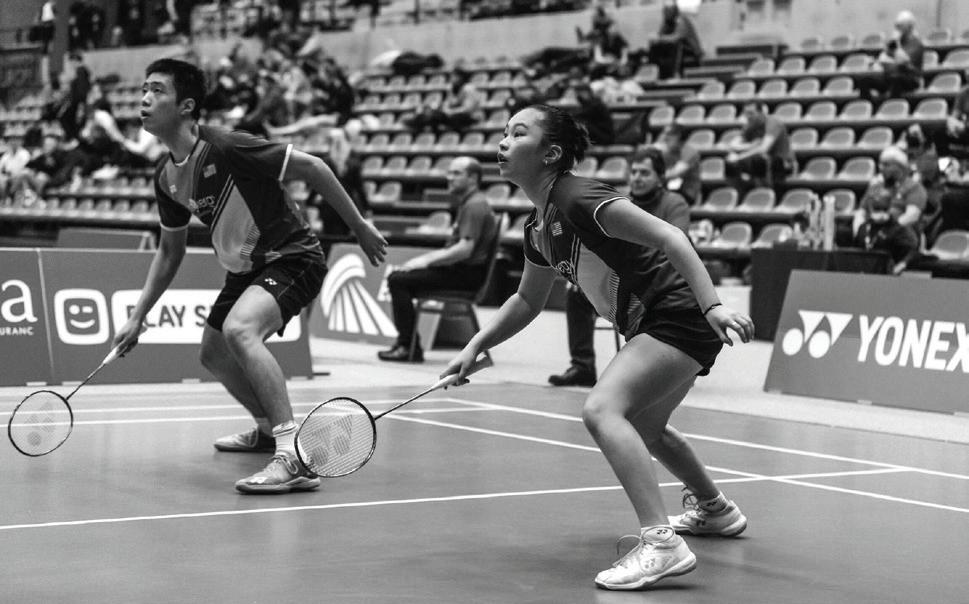
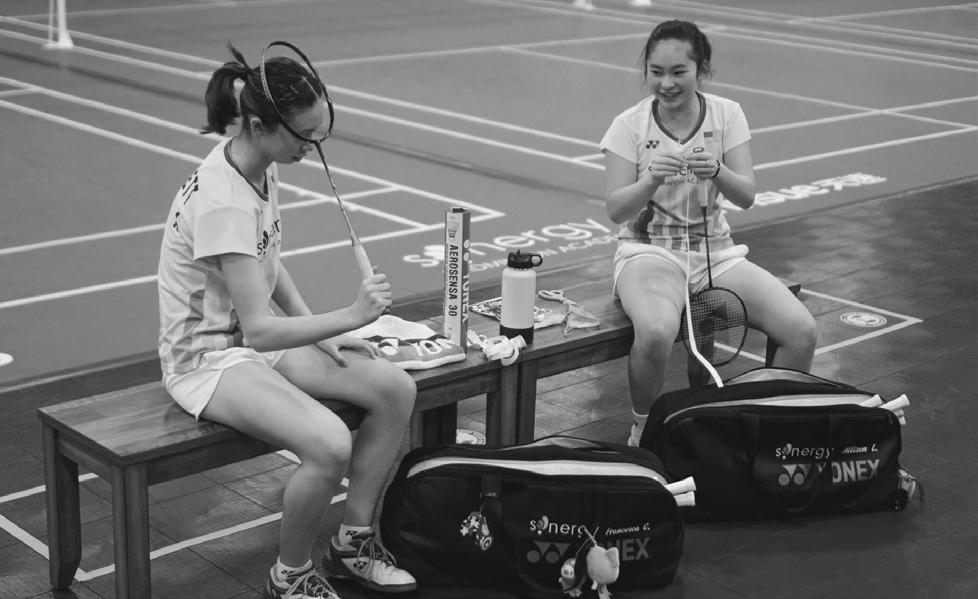
Lee, on the other hand, has to manage her responsibilities as both a competitive athlete and
student. “In the beginning, it was definitely a struggle,” Lee said. “I definitely had some issues with balancing the two. But I found that communicating with my teachers, my parents, my coaches and especially my counselor helped a lot. The Gunn administration has been extremely supportive in my goal to compete in the Olympics. I definitely couldn’t have done all this without their support.”
Lee is often forced to miss school to compete in international tournaments all around the world. She has competed in many parts of the world including countries in Asia, Europe Pan America (North America, South America and Central America). One of the most
Though she enjoys the social aspect of the tournaments, Lee’s vision never strays from the ultimate goal of qualifying for the Olympic Games. Every tournament is an opportunity to get one step closer to reaching her goal. “My most recent tournament in Canada gave us a boost in rank,” Lee said. “We moved up about 15 places which gives us a current rank of 55th in the world for women’s doubles.” Lee has eight months to improve her ranking to the top 8 or to one of the best in Pan America, as the race for the 2024 Summer Olympics will officially start in May of 2023 and conclude in May of 2024. As opposed to other sports such as gymnastics or swimming that use Olympic Trials to select representatives, badminton athletes qualify by their world ranking. The Badminton World Federation uses that one-year qualification period to choose who will be representing their respective countries.
As Lee’s time in high school slowly winds down, she has begun to consider her post-high school plans. “I’m applying to all colleges in the Bay Area,” she said. “I might also potentially take a gap year next year depending on how I feel. But I’m going to stay in the Bay Area for training because it’s the best in the country.”
Allison Lee’s Career


Sports 13Friday, October 28, 2022
Chinyoung Shao
1. First place at every junior national title American titles from U13 to U19.
National Championships for women’s doubles (youngest team to ever win national title).
4. Youngest to participate in the 2022 World Championships in
Left: Senior Allison Lee lunges across the court to return the birdie at the U19 Junior National finals.
Photos courtesy of Allison Lee
—Written by Kenneth Soh
“I’ve always had the Olympics in mind, but it wasn’t until the beginning of high school when I started to take it very seriously.”
—Badminton player senior Allison Lee
Middle: Lee prepares to receive the opponent’s serve against Austria at the Yonex Belgian International 2021.
Right: Lee and her partner Francesca Corbett bond together and rest after a long, strenous practice.
athletes balance competition, mental health

Grueling hours at practice. Long, exhausting weight room sessions. Meticulously counting of grams of protein in meals. All of the listed activities are some of the measures certain athletes implement in order to keep in peak physical health. In the pursuit of maximum performance, they often make many sacrifices, both intentionally and unintentionally — and mental health is often among those given up. For those whose only interaction with student athletes is cheering them on from the bleachers, such a claim might be surprising to hear. What could be so hard about just playing a game? However, for student athletes, playing a sport is certainly not just a game.
Athletic activities are inherently full of stress. After all, the intent of all the training that athletes undergo is to compete in a high-stakes environment. This stress can easily make its way into the subconscious of athletes and affect their mental states. Cross Country Coach Karen Saxena has seen this happen to a number of athletes. “Sometimes when people start getting too good or they take it too seriously, it becomes [a] thing that they have to do well,” she said. “They’re too worried about being perfect and doing everything right. [Students are] not focusing on just trying to take on challenges and improve
and it gives them a chance to really work through things,” she said. “That’s always been the case for me.” Physical Education (P.E.) Instructional Lead Matthew McGinn had a similar experience with playing sports. “For me, athletics has always been a positive thing and I always enjoyed what I was doing,” he said. “In high school I competed in three different sports over the four years. I did football, wrestling and track, and I enjoyed them all. So I think that helped me to have that balance, not only athletically but socially.”
Having diversified his own athletic experiences, McGinn encourages student-athletes to do the same. “What I see a lot of, unfortunately, is when a kid focuses on one specific sport, [they get] burned out on it,” he said. “Not to mention overworking muscles and getting overuse injuries.” Although it may seem counter-intuitive, McGinn believes that diversification is key to not only high performance but better mental states as well. “If someone is serious about moving on to the next level, whether it’s college or beyond, oftentimes what you’ll see is that they were able to diversify their athletic experience [by] experienc[ing] different things and different people,” McGinn said.
as an athlete with my performance as a human being,” Schultz said.

Similarly, Saxena advises approaching sports with a particular mindset to deal with letdowns “It’s all about setting goals and trying your best to achieve them, and if you don’t achieve them that’s ok, it doesn’t matter,” she said. “If you focus too hard on that, it feels like you’re grading yourself. You have to think of it as something special for yourself, not for anyone else to judge or tell you that you’re not good enough.”
 —Written by Victor Dang
Cross Country Coach Karen Saxena
—Written by Victor Dang
Cross Country Coach Karen Saxena
themselves into a better runner, a better person and a better teammate.”
However, not all of it is negative. When done properly, athletics can result in improved health, both physically and mentally. Indeed, the majority of athletes do sports with the intention of benefiting from those effects. The athletic experiences of water polo player junior Julian Schultz have been largely positive. “Playing water polo has been a very good use of time,” Schultz said. “I’ve definitely become more fit [and] a lot more healthy because of water polo.” Schultz concedes that there is a very large time commitment that comes with sports. “There’s definitely the balance of it being harder to manage time,” he said. “You just have less of it. I still think [sports is] definitely good for mental health though. I would not be a happy person if I wasn’t active often.”

Saxena believes that sports can even provide relief from stressors outside of sports. “It’s a positive outlet,

Saxena gave her own advice regarding having a healthy mindset towards athletics. “I’m a very competitive person, but I think when being competitive you also have to make sure you’re having fun,” she said. “If you’re just going through the motions of the fun part and not really enjoying it, then it just becomes another thing you have to get through, like school and classes.”
Losses and missed goals can be hard on athletes, especially when the stakes become much higher than they were prior to high school. However, Schultz believes that if one thinks about athletics the right way and understands that sports is only an aspect of their lives and not the entirety of it, failure can begin to seem less monstrous. “It can definitely be frustrating when you don’t perform to your expectations, or to your goals, but I separate my performance
Team captains give fall sports update, season Highlights
“We haven’t been doing the best because a lot of our seniors have graduated, but I think we’ve really pulled through as a team. One of our best players got sick but we managed to do well. [Throughout the season] we wanted to have fun and play well [and] also keep our differentials low. We definitely struggled a lot in the beginning, but we’ve come to a good point.”
“We’ve played a lot of five set matches and we’ve lost in the fifth set a couple times, which is frustrating because we [were] so close to winning those matches. But, it’s great to see that we’re able to keep up with these really fast-paced teams and stay neck and neck with them. We just need to work on executing the last set and pushing through. We’ve also been doing a good job getting in the zone and really pushing our limits.”
“My favorite part of the season so far is the little talks the team has before or after practice and games. It speaks a lot for a team in general if you’re able to be close both while you’re in practice and while you’re out of practice. [This is] something I’ve always loved about the Gunn water polo team, because I feel like I’ve gotten to know all of them really well outside of the sport.”
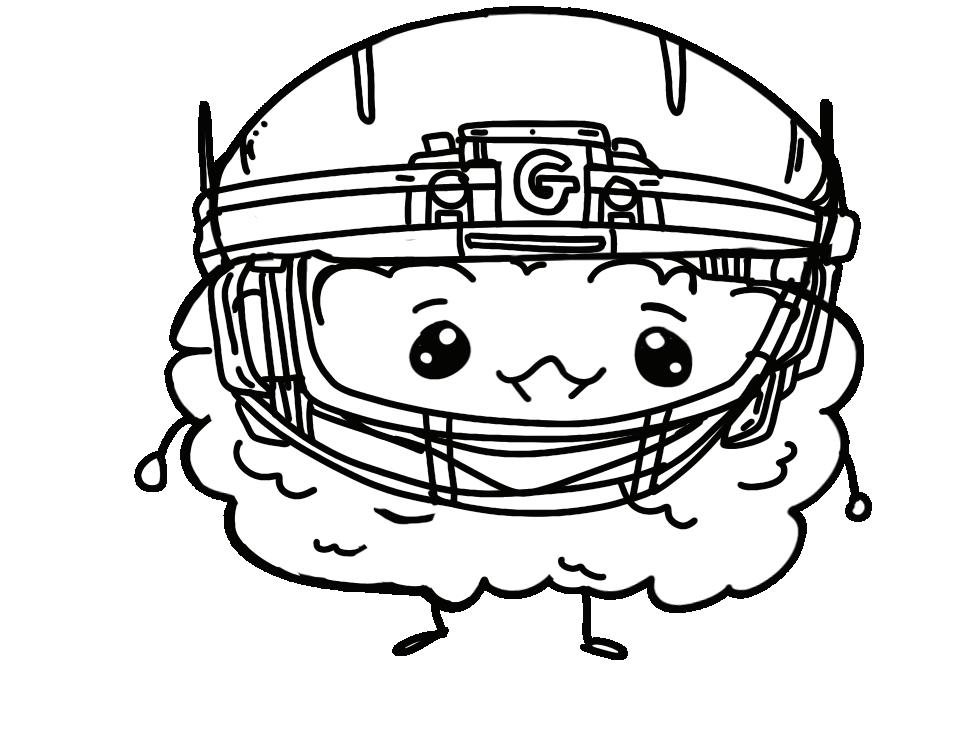 Compiled by Sophia Hwangbo
Compiled by Sophia Hwangbo
14 SportS
“They’re too worried about being perfect and doing everything right and not focusing on just trying to take on challenges and improve themselves into a better runner, a better person and better teammate.”
Vivian Studdert
—
Gracie Easton
Courtesy of Sam Zeng
Tips to balance sports and mental health • Manage your time well (get a planner) • Communicate with your coaches • Recognize when you need to take time off • Don’t put too much pressure on yourself • Practice meditation Check out @gunnoracle on Instagram for more fall sports coverage. Golf Volleyball Water Polo Senior Stephanie Yang swings her club while playing. Senior Kyra Xue prepares for the next set during a game. The girls water polo team chants to hype up each other. Golf team captain senior Stephanie Yang Volleyball team captain senior Kyra Xue Girls water polo team captain
senior Kenza Ashworth
Football plays importance in society, Gunn culture
Over the past few decades in America, American football has surpassed baseball and basketball by a large margin in terms of viewers. According to NFL Football Operations, the 2022 Super Bowl LVI was the most popular televised football game, with over 112 million viewers—making it the most watched sporting event in America. This year at Gunn, attending football games is the most popular choice out of more than a dozen sports, with 52.9% of the 200 students polled choosing football. No other sport gets this much attention, so what makes football so different?

American football, or gridiron football, is a sport loosely derived from soccer and rugby. The first collegiate-level football game was in 1869 between New Jersey’s Rutgers University and Princeton University. There were 25 players per team, aiming to advance a round ball to the opposing side of the field without carrying it. Although that game was vastly different from modern football, it set the stage for America’s most popular sport. In 1880, Yale University player Walter Camp introduced 11 player teams and the “snap,” which involved the quarterback and the center player, initiating the start of an offensive play. Two years later, the rules were amended by Camp so that teams were limited to three downs, in which they had to advance a minimum of five yards in order to keep the ball. This led to the marking of yard lines in multiples of five, resulting in the name of gridiron football. Now, players are allotted four downs to advance a minimum of 10 yards.
High school football began in the early 20th century and has slightly different rules than collegiate football. Its rules are dictated by the National Federation of State High School Associations (NFHS). Some key differences between collegiate and preparatory football are quarter lengths, kickoff starting lines, touchback rules and penalties.

Gunn’s football team was established in 1964 with a small junior varsity (JV) team. In 1965, a varsity team was formed. The Gunn football team had a rough start—with three JV players being cut in 1964 for illegal alcohol use. Additionally, during its first season, the varsity team had a losing streak of 0-8. However, Gunn

finally won their first varsity game against Carlmont in 1965, breaking Gunn football’s previously unsuccessful outcomes.
Although Gunn football is traditionally known to be less athletically gifted than its neighboring school, Palo Alto High School (Paly), the Gunn football team has won two league championships: one in 1971 and another one in 2021, as well as several California Interscholastic Federation-Central Coast Section (CCS) playoffs.
Varsity football player junior Nolan Tok believes football is an important component of high school, despite Gunn’s poor performance in recent games. “Compared to some other schools in the area, our team
There are many traditions integrated into the culture of football such as tailgating: a pre-game ritual in which fans hang out, often barbecue food and dress up in fan gear. At Gunn, football games are one of the few chances outside of spirit weeks to dress up in different themes to showcase Gunn pride and have fun.
Although the number of players have decreased as time has progressed due to fears regarding serious injuries, football is still known as one of the most prominent high school sports. However, Johnson notes that other high school sports have also been gaining popularity in recent years. “For a long time, football was the big fall sport,” Johnson said. “Then water polo became more popular, and then lacrosse.”
Bucklin believes that in spite of the lack of attention towards other sports, football still deserves its popularity. “I think football is fairly emphasized [because] a lot of the kids on that team are not a part of other groups on campus,” she said. “Because it’s such a big team, it’s giving them a platform to be seen and share something about them. There [are] a ton of kids on that team that don’t do other stuff at Gunn and this is their way to be a part of the community.”
is not that great,” Tok said. “However in terms of the team itself, we still have fun just like any other team.”
Sports Commissioner senior Pooja Bucklin notes that football receives a significantly higher level of attention in comparison to other sports. “We have a lot of sports at Gunn that are really [good] that don’t get celebrated at all,” Bucklin said. “Our tennis team is really good. No one talks about it. Our girls water polo team is really good. They won a lot of titles, [yet] still a lot of the focus is on football.”
Gunn football commentator Chris Johnson speculates one reason behind football’s popularity in terms of fans and attendees is the fact that it is a very social sport. Fans are passionate about their team and a culture has formed between the various teams, fostering competition and deep loyalties. “There’s rivalry,” Johnson said. “There’s camaraderie. [It’s] a lot of fun.”
Overall, football will remain a central aspect of high school. Football games are an event where various subgroups of school life can unite and demonstrate school spirit. Tok explains that homecoming was a big influencing factor in his decision to pursue football. “The culture around football is pretty fun and lively,” Tok said. “Things like the Homecoming Game and the Paly game makes you want to play.”


Bucklin feels that any student can enjoy football, regardless of their level of understanding of the sport. “Football [is] a big sport that brings a lot of people together because it’s something you can have fun at, even if you don’t really get it,” she said. “You don’t even have to know what’s going on—you can just scream and it’ll work. That’s the [most fun] part about it. Football just really brings the community together.”
Written by Diya Bose-Malakar
15Friday, October 28, 2022SportS
Snapshots: Gunn Football games through the years 52.9% of students surveyed attending Gunn sports games attend football games Players huddle on the field before a play against Monterey High School. The cheerleaders hold up the banner at the 1986 Homecoming Game. 1 9 7 6 1 9 8 7
Owen Koehler
2 0 2 2
Photo from the 1987 volume of “The Olympian.”
Photo from the 1976 volume of “The Olympian.” Photo from the 2007 volume of “The Olympian.” 2 0 0 7 Players get into position as the clock winds down in the first quarter. Gunn cheerleaders and spectators cheer on the football team at a game. “Football [is] a big sport that brings a lot of people together because it’s something you can have fun [with], even if you don’t really get it.” Sports
Commissioner senior Pooja Bucklin
Source: Survey sent out to Gunn students with 200 responses
Last-minute DIY Halloween costumes



Join the Scooby-doo mystery Gang
Have three friends and a dog? No? That’s okay—any member of the Mystery Gang is highly recognizable and also fairly practically dressed. Shaggy has the easiest costume: brown pants, a green shirt and a laissez-faire attitude are all that you need. However, to really sell the character, you can also tape a “Scooby Snax” sign to a cereal box and carry that around with you as a prop—bonus points if you’re also constantly shoveling Cheerios into your mouth.

If Shaggy isn’t your style, there are four more characters to choose from, although some may be harder to dress up as than others and one may be a canine. The most important factor to keep in mind is the color scheme: you come across as Velma as long as you have orange on top and red on the bottom. The glasses, however, are indeed crucial. Furthermore, drawing freckles and wearing knee-high socks are great add-ons for those who want to go the extra mile. Fred also has a fairly simple outfit: white shirt
Be a Pop-Tart

and blue pants. What makes him discernible, though, is the orange neckerchief, otherwise you’re just wearing a regular outfit. The orange neckerchief is a dealbreaker, so if you can’t source one another outfit might be the play.
Daphne and Scooby-Doo have the most difficult looks to steal, what with Daphne being a canon fashion icon and Scooby being, well, a dog. However, if you have enough purple and green things in your wardrobe, a Daphne costume is certainly possible. Scooby, on the other hand, requires one very special accessory: his collar. An all-brown outfit is more than doable, but the collar is a gray area. Scooby-hopefuls can construct one out of cardboard and paper, but in all honesty, that just seems like too much work.
There has to be a cardboard box somewhere in your home that can be repurposed as a convenient and delicious breakfast treat—the Pop-Tart. Similar to the fruit costume below, this one is highly customizable and can be tweaked to fit your taste in tarts. All you need is a large cardboard rectangle, construction paper, glue and markers, and you can be any PopTart that your heart desires.
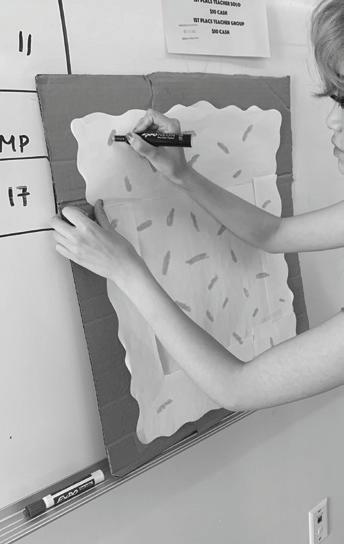
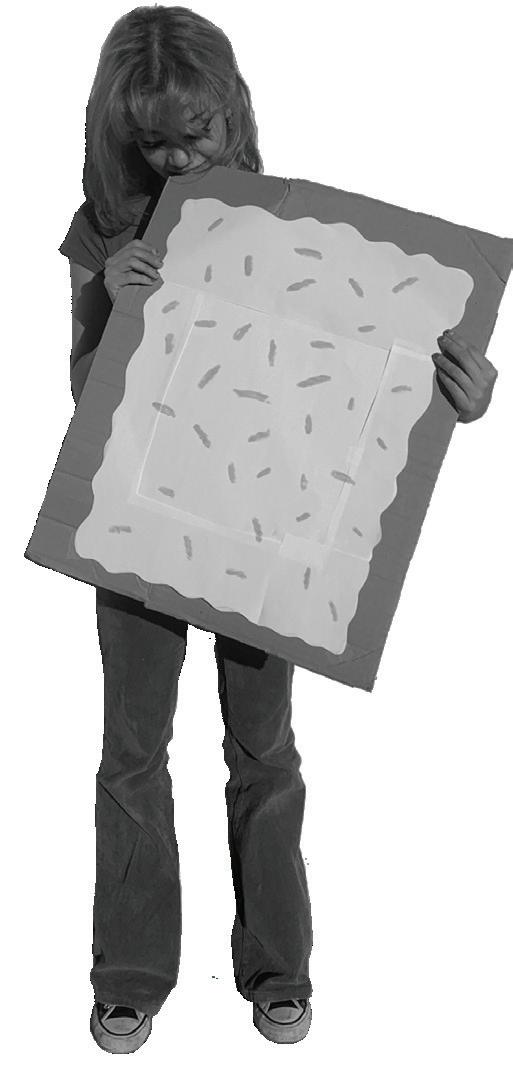
Cut the construction paper to have wavy edges and glue it to the cardboard. You may need to create a border of wavy-edge construction paper and fill it in with more sheets, though. From there, use the marker to draw the tiny little dots in the frosting—we may not know what they are, but they’re an essential part of the image. Using different colors of construction paper and different colored markers, wearers can decide which

Dress up like a fruit

What’s better than a costume that covers an entire food group? Dress up in monochrome colors, wear a leaf on your head and boom—you’re a fruit. All purple outfit? Grape. All yellow? Lemon. All orange? Guess what, you’re an orange! What’s great about this costume is that it’s highly customizable and wearers can make it more complex depending on the amount of time and effort they’re willing to put into it. For example, sticking pompoms onto a purple or green shirt can really help to sell the bunch-of-grapes look, and carrying a carton of fruit juice to coordinate with your costume can help make it instantly discernible. Additionally, consider dressing up with a group of friends to be a fruit salad.







It’s also easy to dress your outfit up for Halloween parties or dress it down for school, since all that really matters is the color of the outfit and the foliage on your head. The most difficult aspect is the leaf or stem—it’s highly important to the costume and a necessary
flavor they want to dress as. Pink paper and red dots can be constructed as either cherry or strawberry PopTarts, purple paper and bright blue drizzle-shapes are clearly Frosted Wildicious Wild Berry (trademark) tarts, and if you have no construction paper, no worries. Draw some brown dots on a plain piece of brown cardboard and you are the OG unfrosted PopTart. To be honest, I don’t quite know how to tackle the Pop-Tart filling, so we can pretend it doesn’t exist and then move on—unless you want your costume to have a horror aspect to it, in which case, go for the strawberry-flavored tart and drizzle fake blood from your mouth. After all, just like Pop-Tarts are filled with flavorful goodness, humans are filled with blood. Use this to your advantage. No matter what you choose to do, this costume is undoubtedly crazy good.
Behind the scenes of the design process!
accessory to make clear what you’re dressing up as. Have no fear, though; there are many ways to make leaf headgear. For one, you can find small fake plants—there are many varieties at Michaels—and glue the leaves to a headband. Long, spiky leaves and a yellow outfit makes for an adorable pineapple (consider also adding fangs, since pineapples bite back). On another vein, wearers can also sport a green hat to emulate a leafy top; you can stop there, or you can cut leaf shapes out of green felt and pin them to the hat as well. However, I would steer clear of vegetation such as bell peppers or kumquats— nobody will know what you are.
 —Written by Becca Wu
—Written by Becca Wu
Comic strip: Ollie finds a delicious halloween costume
Natalie Lam
Aeron Man
Vivian Studdert
Vivian Studdert
Becca Wu
Vivian Studdert
Vivian Studdert
Vivian Studdert
—Written by Becca Wu
—Written by Becca Wu
Vivian Studdert
Becca Wu
16 Lifestyle
What’s under the bed: Gunn’s worst fears revealed
The passage of time, ketchup, people with large eyes, empty eye sockets and death: these aren’t elements of a horror movie, but some of Gunn students’ worst fears. Some of these fears incapacitate nearly all of us to some degree. For other, rarer fears, it takes having them to truly understand how terrifying they are.
fear of Ketchup
It’s the perfect condiment to fries, sauce for burgers and drizzle on hot dogs. It’s also senior Allyson Dinh’s worst fear: tomato ketchup. In fact, Dinh has never eaten ketchup and avoids touching it at all costs, because she is repelled by its sight and smell. As funny and inexplicable as her friends—and Dinh herself—find this fear to be, she describes it as akin to what someone afraid of spiders might feel upon seeing one. “My friends would chase me around with ketchup packets, and it’s genuinely terrifying to me,” she said. “I’ve had legitimate panic attacks from people chasing me with ketchup.”
Dinh traces this fear to elementary school, when people placed ketchup packets under the toilet seats, causing ketchup to explode on the walls. “People would also just put ketchup everywhere—they were on the rock walls and on the tables,” she said. “I [thought] that was the most disgusting thing ever.”


The closest time Dinh has come to eating ketchup was when a friend dared her to try it for 10 dollars. Dinh couldn’t bring herself to taste it. “I stared at it for 30 minutes,” she said. “I was crying, and I was [saying] ‘I can’t do this,’” she said.
Although her fear of ketchup doesn’t impede her everyday life, she does face small inconveniences. When confronted with ketchup (such as next to her fries), Dinh has to ask others to move it for her. “Mustard is fine, mayo is fine and everything else is fine,” she said. “I just don’t know what it is about ketchup [that makes] it one of the worst [things] ever.”
fear of Time passing
It’s not uncommon for worst fears to veil others. Junior Irene Kim describes her worst fear as not having enough time: being unable to reach her career and life goals as a result. “I have the fear of running out of time, despite not doing the activities that I want to do in a way that will push my life and my career forward,” Kim said.
COVID-19 quarantine first caused Kim to spend more time on unproductive activities, exacerbating her fear of running out of time. According to Kim, she often opted to listen to music or scroll on social media instead of being productive during her free time. “To cope with [the loss of social interaction], I pursued random, meaningless tasks that gave me a sense of happiness,” she said. “Even though I knew what I needed to be doing—for example, studying—I did these things to make myself feel better.”
Kim has put strategies in place to reduce this fear, such as using a calendar to organize her time better, but she acknowledges that unwavering self-discipline is difficult at times. “I still find myself self-sabotaging,” she said. “I do get mad at myself for it. But then at any given moment, I just do what I feel like doing.”
Chronophobia is ultimately a common fear, according to Kim, with many people having a derivative of it. Kim offered her take on how to approach this fear. “Everyone runs out of time in the end, so you should just do what you like doing,” she said.
fear of eyes
Never mind the eyeball-filled jars of horror movies— junior Melissa Sandoval, whose worst nightmare is people with large eyes, has to face her fear on a frequent basis. She finds it petrifying to come across people whose eyeballs seem to be on the verge of popping out. “I feel like I’m constantly being watched, because they just have such big eyes,” she said.

Sandoval’s fear of people with large eyes has hampered social interactions, sometimes making it difficult for her

to interact with people. In an anxiety-inducing experience with a large-eyed new acquaintance, Sandoval was nervously observing their large eyes from the onset, but it was only when they laughed that Sandoval felt the need to leave. “Their eyes just blew up,” she said. “I got really anxious and I was like, ‘I want to leave.’”
On the other hand, junior Callum Budas fears not the presence of large eyes but the absence of them. Budas’ fear of empty eye sockets developed when he watched “Coraline”—a kids’ horror movie where the characters have buttons for eyes—as a child. He generally feels trapped and uncomfortable when confronted with images of empty eye sockets. “It’s so disgusting for me,” he said. “I’m stuck in a moment of being frozen.”
Encounters with empty eye sockets can leave lasting impressions. Budas once saw a woman with no nose, no eye and no bandage covering either in Santa Cruz. “I still have that image in my mind,” he said. “It’s kind of a scar.”
fear of death
It can take just a single incident for dormant fears to emerge into full-blown phobias. After sophomore Raph Zhu was followed back home after last year’s Homecoming dance by two men in a car, he started to feel a stronger fear of death, because he grew more concerned for his safety. He describes the fear as being connected to a fear of the unknown and fear for his safety. “It’s about not knowing if the neighborhood is actually safe in Palo Alto [and] in general,” he said.

Knowing dangerous situations like this might happen again has put Zhu on guard more often. “When I’m on my own, or especially at night, I’ll just pay way more attention to what’s going on and who’s behind me or in front of me,” he said.
When he’s alone, Zhu often considers what might happen and how he might react in similar situations. “It’s just a really scary thought to me,” he said.
—Written by Irene Tsen
Faces in the Crowd: What was
fear?
by Chris Lee
your childhood
“A childhood fear for me was go ing upstairs because there wasn’t a light on the stairway so you had to go up in the dark. That scared me a lot, so I just refused to go upstairs for about six months of my life.” —Sam Laxman (9)
“My
greatest fear was old people. When I was only 3’11” and everyone older seemed to tower over me, I felt like I was about to be punted like a football.” —Aydan Chen (10)
“When
I was little my greatest fear was Michael Jackson. Everything about that man absolutely terrified me. I had recurring nightmares of him chasing after me while speed moon walking. I would check under my bed at night just in case he was hiding there.” —Jaz Decrem (11)
“I
was always scared of splinters, so much that to this day I still don’t like to touch bare wood. I’ve overheard something about splinters having the ability to travel up your blood stream to your heart and kill you, so I’m not trying to go test that theory anytime soon.” —Obed Han (12) —Compiled
Irene Hong
17LifestyLe Friday, October 28, 2022
behind the Scenes: gunn instagram accounts

Gunn students have created various Instagram accounts dedicated to documenting life on campus, including accounts which post photos of students eating bananas, sleeping in class and behind-the-scenes shots from student-led elective classes. Along with the older and more serious accounts such as @gunn6thman, students have created some frivolous accounts in the last few years, allowing them to share their passions, voices and random humorous insights.
For around five years, the Gunn Style Watch account featured students and their outfits. After previous owner alumna Anna Toksvig graduated in 2022, she decided to retire the old account, @gunnstylewatch. This year, senior Fae Crane created a similar account, @gunnstylewatchrev, for the next generation of students. She decided to create the new account due to her interest in fashion. “I enjoy finding different styles around Gunn,” she said. “A lot of the time in the hallways, I like to look at other people’s outfits and [think], ‘That one’s cool,’ so I thought it would be fun to document that on an account rather than just in my head.”

Conducting interviews is one of Crane’s favorite parts about running the account. “I like talking to people about what inspires them because a lot of the time you never actually know what they’re going to say,” she said. “It’s really interesting to hear where people get their ideas from and for them to pull something out and be like, ‘This is what inspires me.’”
Crane hopes the account can act as an inspiration board for other students, showcasing many styles in its continuous posts throughout the year. “Although I haven’t posted too much yet, I’ve been trying to [capture] different styles recently, and hopefully throughout the year I can grow the styles that are represented on the account,” she said.
@gunnburrito is a newer account that started in April of 2022 by seniors Anya Lin and Kai Porter. The idea came about after a friend suggested that Lin take an inflatable burrito to Prom as her date. From there, Lin and Porter decided to personify the burrito as a Gunn student and, naturally, create an Instagram account for it. The burrito attends many Gunn events, such as Homecoming Week, football games and more. Lin and Porter style the burrito for these various occasions. “We go around [Goodwill] looking for all kinds of supplies,” Porter said.

Lin enjoys how the burrito’s attendance adds to the hype of events. “When we bring the burrito to events it makes people happy,” she said. “[It’s] nice to know that such a silly idea we had actually has an impact.”

One Gunn account that has been around for more than a decade is @gunn6thman. The account is meant to highlight the importance of the student section at games. Basketball games feature five players on each team, and the “6th man” cheers on the team before leaving the bench and entering the game. This account was created by the Student Executive Council for the sports commissioner to run as a way to inform the student body of sporting events and engage the student section at games.
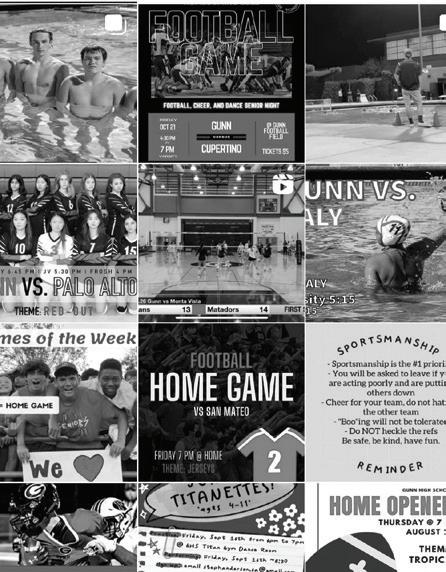
For the past three years, Sports Commissioner senior Pooja Bucklin has run the account. “It was created to advertise games more, get the word out about sports that aren’t just football or basketball and organize themes,” she said. “We also wanted to create a social media platform where people can get information on games because not everyone is checking their Schoology avidly.” Through the account, Bucklin hopes to encapsulate the environment of games, along with providing information about them. “I’m trying to have more of a casual feel and capture the atmosphere of being at games and how fun that is,” she said. “[But] we also include information about what games are coming up and how our teams are doing.”
Bucklin has seen a large increase in the number of people who attend sports games. “Before COVID-19 not a lot of people went to games and we didn’t really have a student section,” she said. “But now we’ve grown a lot, and I think that’s largely because the account has doubled in followers and more Gunn students know about it.” Throughout the sports events that have occurred so far this year, Bucklin particularly enjoyed the spirit of the student section at the Gunn vs. Palo Alto High School (Paly) football game. “There were so many people there, and everyone was so hyped,” she said. “Our student section had really good sportsmanship. It’s really important that students celebrate our teams and be excited, but also maintain respect for everyone there.”

Students offer tips, tricks on personal style, care
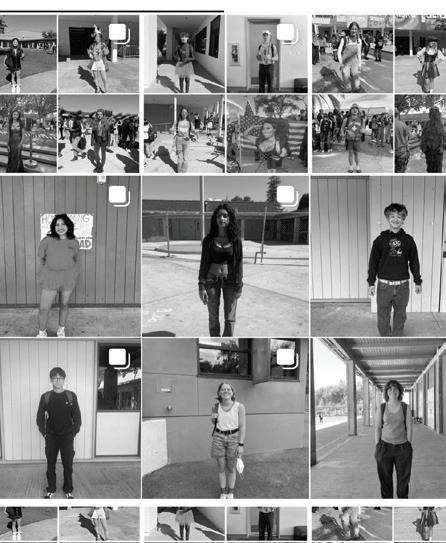
Stella Manning: Fashion
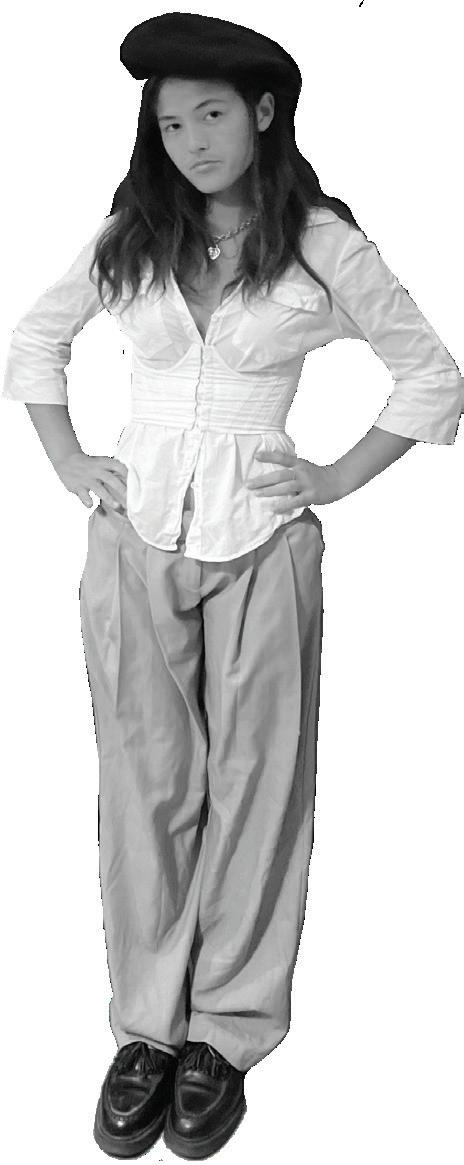
Junior Stella Manning sees fashion as a form of self-expression and something that brings joy to the wearer. “It’s about expressing one’s mood,” she said. “[If students] are more sporty, they could get a piece that they think is cool and then build their outfit around the idea of making it more comfortable. If you want to be more fashionable, go thrifting or go to a store you like and then pick out one piece that provokes that feeling of, ‘Oh, I love this piece’—then you can build off of that.”
Manning noted that her personal style changes on a daily basis. “I think [my style] changes in a way every day. It’s based on how I’m feeling, whether I feel more comfortable in something more relaxed or [whether] I want to make a statement with a certain piece in my closet,” she said. “There’s a bunch of different ways that I can pair things together.” She sources her clothing from thrift stores, clothing stores and her family members. “I’ve gotten items from my aunt who’s really into style, so I pull inspiration from her,” Manning said.
For students who want to put together cohesive outfits, Manning encourages them to focus on pairing the right pieces together.
“If [individuals] want to make their outfit tie more together, they can’t pair something flowy on top with something flowy on the bottom, because it doesn’t exactly match,” she said. “They have to pair it in a way where it fits your frame. The styles don’t have to necessarily match, but I’d say bringing in color [is important]. So if they have black shoes, then bring it together with something black within another part of their outfit.”
Adele Davis: Hair Ollie Fong: Fashion
Senior Adele Davis maintains a consistent daily routine to take care of her hair, taking the time to make sure her hair looks its best. As someone with curly hair, she finds that curls require additional effort to take care of when compared to straight hair. “It takes a little more product and a little more time to take care of,” she said. Davis believes that people who currently lack a hair care routine could benefit from a simple daily routine. “There are different levels that [individuals] can take care of [their] hair on, but just putting an extra five minutes in the morning can be helpful or easy for a lot of people,” she said.
When showering every day, Davis begins by using a specific type of shampoo. “I use one without sulfates because that’s healthier for the hair,” she said. Sulfates are chemicals that create a lather when shampoo is mixed with water, and remove dirt and oils from the hair. However, they are a strong ingredient that can strip away too much oil, leaving the scalp and hair dry. After shampooing, Davis conditions her hair with conditioner containing argan oil, a natural substance that helps the hair maintain its moisture and protects scalp from dryness. “Then, when I get out [of the shower], I use leave-in conditioner and then gel,” she said. Leave-in conditioner is another type of conditioner which stays in the hair instead of being rinsed out. It re-hydrates the hair after using shampoo and is more beneficial for people with curly hair. Finally, Davis lets her hair air dry.

“Blow drying is pretty damaging for any type of hair,” she said. “For curly hair, it creates a lot of frizz. So air drying kind of reduces that frizz.”
For freshman Ollie Fong, an interest in fashion evolved from a love for basketball. “My love of sneakers eventually got me into fashion,” Fong said.
When Fong selects an outfit every day, he prioritizes comfort above all else. “I wear a lot of baggy stuff, and I like to wear more neutral and toned down colors,” he said. His go-to clothing item is Japanese retailer Uniqlo’s AIRism t-shirt, known for its soft texture. As for shoes, Fong often sports Adidas Yeezy Foam Runners, a futuristic sneaker made entirely of foam that is also known for its comfort. Fong picks out accessories to complete his outfit, which often include jewelry. “For jewelry, I always wear my Vivienne Westwood necklace,” Fong said.
To find better deals and unique pieces, Fong often favors online shopping and secondhand stores instead of purchasing from retailers. “I purchase usually through Grailed, Ebay, Depop or local thrift and vintage stores,” Fong said. “It’s a good way to find more affordable clothing, and it’s all unique.” For students who would like to begin thrifting, Fong believes it to be an accessible entry point into fashion. “Go to the local Goodwill and pick out whatever you think looks cool,” he said. “You just have to not care about what other people think.”
Fong advises students to wear what they like rather than trying to appeal to others.
“You should wear whatever you think is comfortable [and] whatever fits you best,” he said. “Try to find what color palette suits you and your personality. Clothes [should] tell your story and show who you are.”
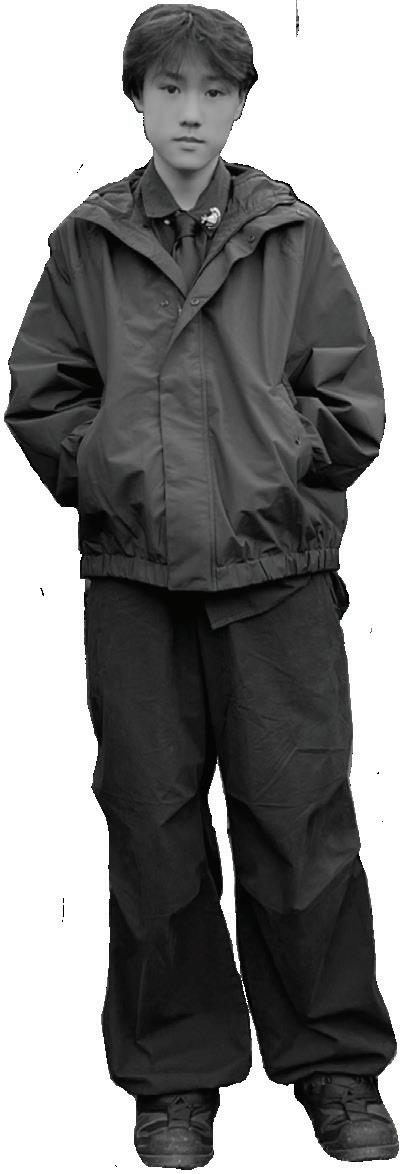
@gunnstylewatchrev @gunnburrito @gunn6thman —Compiled by
Bryan Xiao
Courtesy
of Ollie Fong
Courtesy
of Stella Manning Grace Gao
—Compiled by Safina Syed
@gunnstylewatchrev
@gunnburrito
@gunn6thman
18 LifestyLe
CROSSWORD

So you killed someone at Gunn. Maybe they had a higher GPA or better SAT score than you, but either way, you have unalived someone, and you now have a body to get rid of. Googling disposal strategies would probably only serve to raise red flags and alert the cops of suspicious activity. Maybe you try actually getting one of those VPNs you hear every YouTuber promote. Unfortunately, you look at your card balance and remember you wasted all your money on boba, so that’s kind of out as an option. If worst comes to worst, here’s some advice to get out of that situation.
The first modus operandi is to just hide the corpse somewhere and forget about it, but getting away with murder is, believe it or not, actually a bit harder than that. With pesky new technologies such as electric scooters and golf carts making it much easier to find and locate bodies, it may be a challenge to simply hide the body. Luckily, there are some places around Gunn just for that purpose. There is a myth that speaks of the underground tunnels in Gunn, hidden from obscurity, a perfect place to just perhaps leave a body.

Gunn’s mythic tunnels are hard to come by, so perhaps try some witchery. Once you sneak past the chemistry teachers and fend off chemistry teacher Dr. Heather Mellows’ cats, you














will find the storage of previously brewed concoctions in the J Building. Thinking back to Harry Potter’s vanishing spell, all you need to do is find the vanishing potion labeled “Evanesco” and you’re good to go. Now all you need to do is pour this elixir on the body and you should be in the clear. The body will soon start to disappear before your very eyes, dissolving away and leaving behind no trace. Be careful though: fail and you may just get turned into a lab rat, imprisoned in a small cage in some storage room. This is where the fate of most who fail and suffer the wrath of chemistry end up.
If you’re too scared of being turned into a rat, there is another, possibly less risky method. During school dances, the mosh pit is a place of pure crowded chaos. With hundreds crammed into a small dense group, it’s much easier to have the body just blend in with the sheer population as people dance to the music. When people finally start noticing the body, it’s going to be virtually impossible to single someone out, a perfect
way to avoid suspicion. Though I suppose it may be hard to carry a dead body into the dance. But with the dark lights and low visibility, anything is possible.
Don’t want to socialize and actually talk directly to others? With a shortage of organs available for transplants, there has been a growing demand for organ donations. With organs easily going for hundreds of thousands of dollars on the black market, why not just simply sell off parts of the carcass, not only easily getting rid of the body but also making some more money towards chipping away at that dreadful future college debt.
Of course, these disposal methods are not without their risks, and not committing murder in the first place would probably be the best option. With a little creativity and digging around campus, anyone can get rid of a body and make sure no one knows who did it!
—Written by John Li
Humor: how to get away with MURDER HALLOWEEN
ACROSS DOWN FINISHED? Stop by Room P-115 during 5th period or lunch next week with the completed crossword puzzle for a prize!
Small, scary arachnid Mad scientist who created a popular big green monster with stitches all over him “____ or treat!” Tiny, fuzzy, flying creature that likes to sleep upside down Think fake cobwebs, jack o’lanterns, styro foam tombstones On what lake does Dracula like to water ski? Has fangs and a long cloak, not a fan of gar lic or sunlight Round orange fruit, often carved into a jack o’lantern 3. 4. 6. 8. 9. 10. 11. 12. —Compiled by Hila Livneh
Chinyoung Shao
Color of a cat associated with bad luck A special outfit for Halloween night The bone structure inside your body Translucent figure that haunts old mansions A scary movie and book genre Kids go around neighborhoods begging for it every October A witch’s preferred mode of transportation, also used to clean your home 1. 2. 3. 5. 6. 7. 8.
Natalie Lam
UNSCRAMBLE the boxed letters! 19LifestyLe Friday, October 28, 2022
Collectors share stories behind unique compilations
Sophomore Zoe Heifets: Snow Globes
Amidst the likes of t-shirts, keychains, magnets and postcards, there is one souvenir that sophomore Zoe Heifets cherishes most: her beloved snow globes.

Heifets has almost 20 snow globes in her personal collection, which she started at a young age. “I first started collecting snow globes because my dad had to travel for work,” she said. “One thing he could always find in every place he went to was snow globes.”
As Heifets began traveling, she started customizing her collection. “As I’ve started to travel, I’ve collected snow globes from the places I’ve visited,” she said.
While she does not exactly know why she began
collecting snow globes of all souvenirs, Heifets saw the appeal of them early on. “It was sort of an accident that it was snow globes, but they are a great souvenir,” she said.
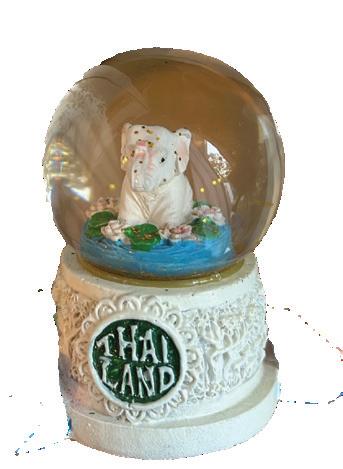
Heifets’ hobby has become an established practice in her household. Now, her younger sister has also started a collection of her own.
Collecting snow globes is a simple hobby that retains memories without requiring large sums of money or time. “It really doesn’t take up that much of my life,” she said. “It’s just a little collection that I add to every once in a while.”
—Written by Dan Honigstein
Junior Jerry Wang: Cacti Plants
Some people like to collect comic books, old coins or even buttons. But very few are collectors like junior Jerry Wang, who is in possession of around 200 cacti plants, ranging in size from a few inches to four feet tall.

Wang’s first cactus came from a friend who moved away in 2012, and it serves as a reminder of them. “Those [cacti] flowers are the last thing I have of that friend of mine,” he said. “They were diagnosed with terminal cancer a while ago.”
From there, Wang’s collection only grew. “I had this upstairs neighbor that had a similar plant to the first one I had, so I propagated that and thought, ‘The flowers were nice, so what if I got more of them?’” he said. While
Wang purchased most of his cacti himself, his hobby is so notable to his friends that he is commonly gifted cacti.

“A large number of my cacti came from people buying me cacti on my birthday,” he said.
Whenever he had money to spare, one of Wang’s first thoughts used to be to spend it on cacti; however, he has begun to pursue other interests. “Now, my thoughts are about using money to buy lab equipment to clone cacti,” Wang said. “I actually started an experiment with it in my Biotech class, although I made a few fatal mistakes.”
Once he collects enough funds, Wang hopes to redo the experiment, correctly this time.
—Written by Lita Sone
Junior Siena Tacy: Vinyl Records
Record players and vinyls are a symbol of the past, and the choice between using them or Spotify seems like an easy one, right? Vinyl collector junior Siena Tacy believes otherwise.

Tacy has over 70 vinyls in her collection and has been collecting them for close to two years. “There is something beautiful about having music in its physical form,” she said. “You can always have an album that you like on Spotify, but there’s something special to me about holding a song in your hands—cover and all.”
After being given her first record for Christmas, Tacy knew she had found something she loved. “My first record was ‘Apricot Princess’ by Rex Orange County,” she said. “It was the only record I had for a while, so I would just listen to it on repeat. I still play it almost every day.”
Tacy enjoys the individuality of each vinyl and how

each one brings something different to her collection.
“All vinyls are different and they each have a lot of work put into them,” she said. “Each artist gets to customize their record and it’s cool to see what they imagined their album to look like in its tangible form.”
Almost as important as the vinyls themselves is the record player. “I originally had a little suitcase record player from the brand Victrola,” Tacy said. After being pulled further into the world of vinyls and records, she upgraded to a more high-tech Fluance player.
When it comes to collecting vinyls, Tacy recommends beginners keep an open mind. “I’ve never gone into a record store looking for a particular record,” she said. “I always end up browsing and picking things that look interesting.”
—Written by Vivian Studdert
Senior Sanjana Rao: ‘Star Trek’ Memorabilia

At three years old, senior Sanjana Rao loved watching rerun episodes of “Star Trek” and the endless possibilities each episode presented. “‘Star Trek’ gave me hope as a little kid,” Rao said. “It was the world I wanted to live in. A world where you don’t have barriers.”
Rao has around 250 “Star Trek” DVDs, a signed shirt and multiple posters and figurines. The first item in her “Star Trek” collection was from a worker in an antique shop who collected “Star Trek” posters and figurines. “We couldn’t afford any of the stuff, but I would just sit there and play around with the collection,” she said. “When we moved out of Colorado, he gifted me over half of his collection of ‘Star Trek’ items.”
Now, Rao’s most prized possession is a replica of the



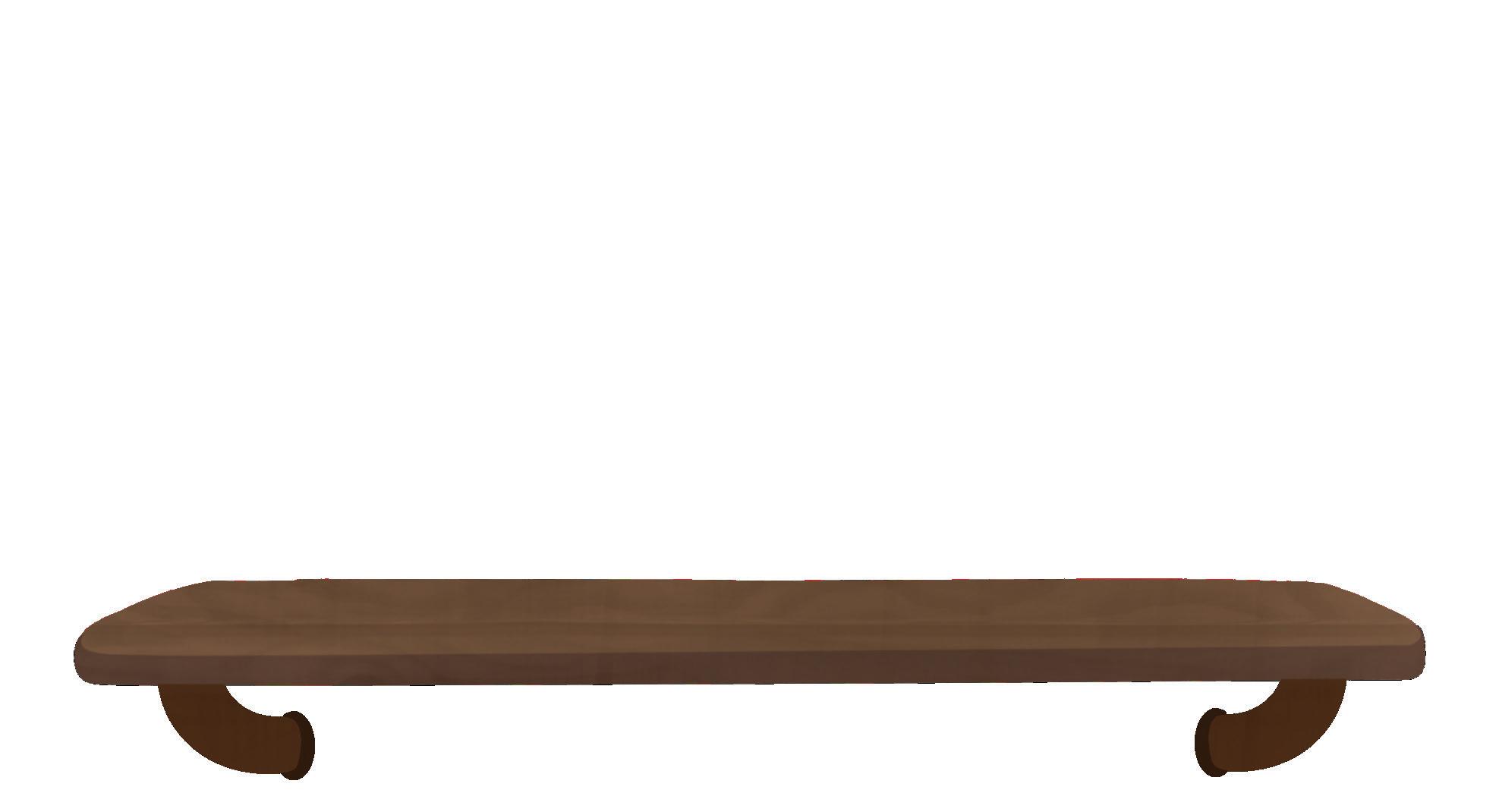

“Star Trek” Voyager ship. “In the story, the characters are lost in space, and they’re trying to find their way home to the ship,” she said. “In a way, the ship represents that you always have something to look forward to.”
Rao’s collection is not yet complete. “I look forward to collecting more antique ‘Star Trek’ items like ship schematics,” she said.
“Star Trek” isn’t just a collection to Rao. For someone who has moved nine times, “Star Trek” has united her family since she was little. “‘Star Trek’ brings us together,” she said. “It reminds us of our past and how much we’ve actually grown from [living in] one apartment to [living in] Palo Alto.”
 —Written by Madison Yue
—Written by Madison Yue
20 Features
Photos courtesy of Zoe Heifets
Photos courtesy of Jerry Wang
Photos courtesy of Siena Tacy
Michelle Koo
Photos courtesy of Sanjana Rao




 Michelle Koo and Chinyoung Shao
Michelle Koo and Chinyoung Shao





















 Kelvin Xu Business Editor
Kelvin Xu Business Editor












 Carly Liao Forum Editor
Carly Liao Forum Editor















 —Written by Becca Wu
Graphics by Irene Hong and Chinyoung Shao
—Written by Becca Wu
Graphics by Irene Hong and Chinyoung Shao
































 —Written by Dan Honigstein
—Written by Dan Honigstein


















 —Written by Victor Dang
Cross Country Coach Karen Saxena
—Written by Victor Dang
Cross Country Coach Karen Saxena

 Compiled by Sophia Hwangbo
Compiled by Sophia Hwangbo
















 —Written by Becca Wu
—Written by Becca Wu





































 —Written by Madison Yue
—Written by Madison Yue